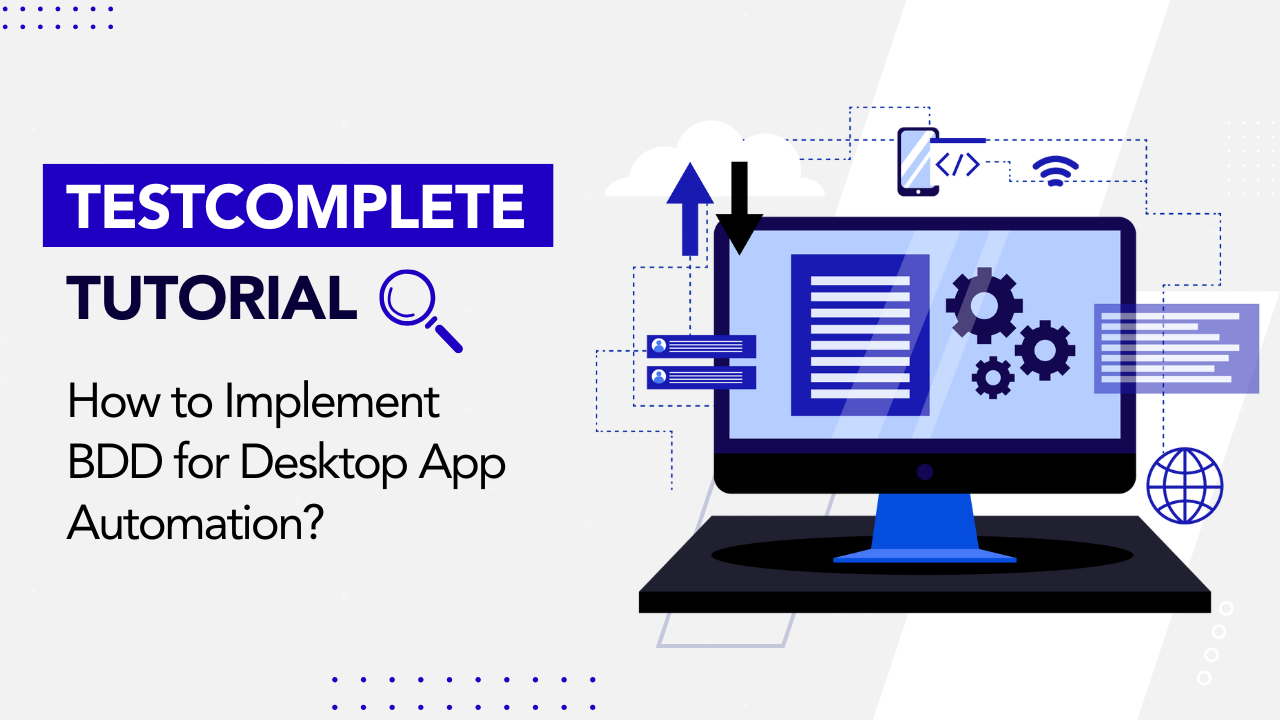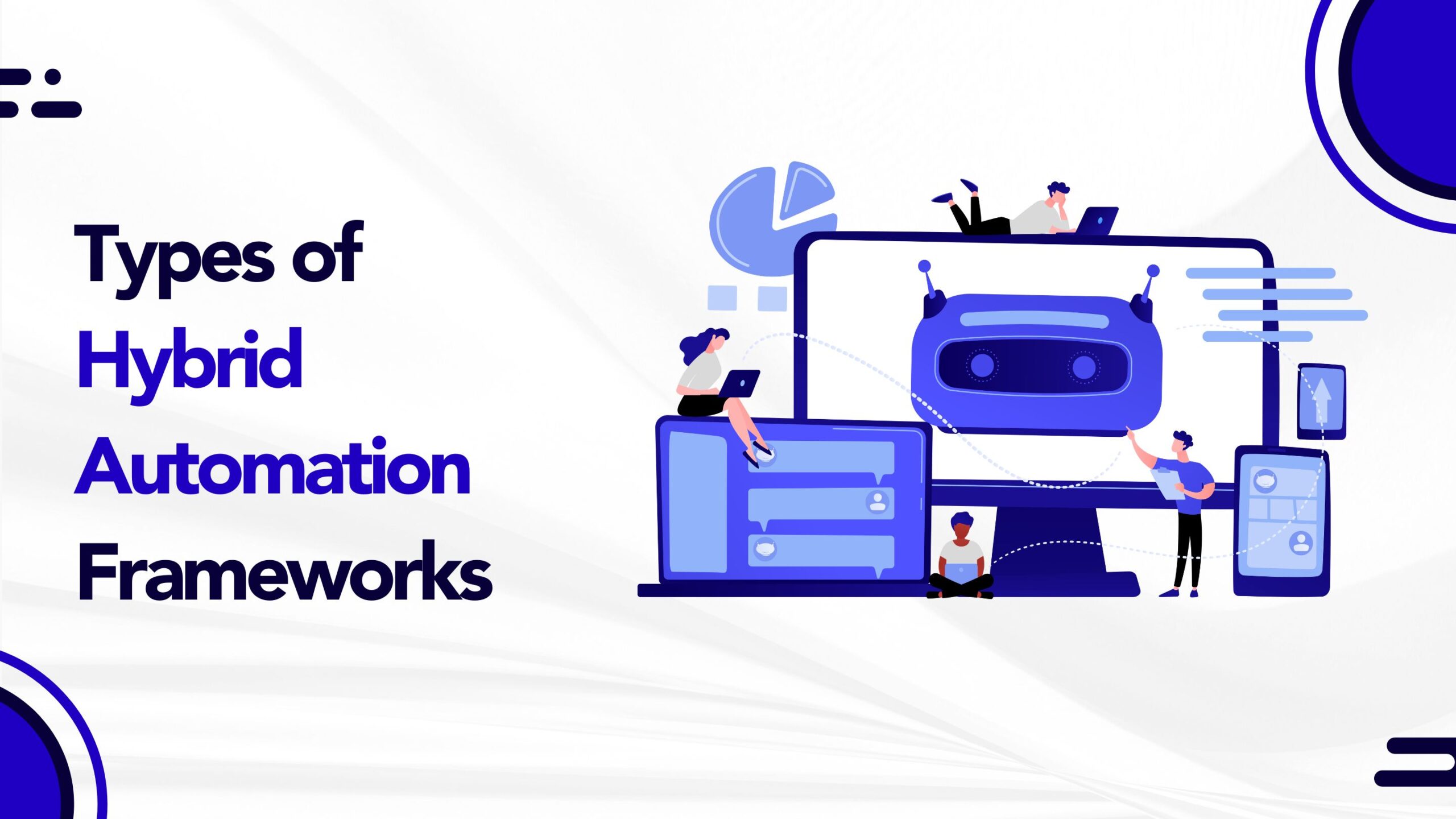
by Anika Chakraborty | Jan 9, 2024 | Automation Testing, Blog |
Playwright is a robust tool that automates cross-browser testing across Chromium, Firefox, and WebKit using a single API. It is an open source software developed and launched by Microsoft in 2020 and quickly gained popularity. Cross-browser testing using Playwright is a seamless process that enables efficient testing to identify and address potential issues, guaranteeing a seamless user experience. Being an Automation Testing company, we have hands-on experience using Playwright for cross-browser testing. So, in our Playwright cross-browser testing tutorial blog, we’ll be explaining how to set up and run test scripts for different browsers in Playwright.
Why is Cross-Browser Testing Needed?
Cross-browser testing is pivotal to ensure web applications work efficiently across different browsers. Users access our website or web application on a diverse landscape of browsers and it’s crucial that our platform performs well on their preferred browser. If our site fails to function adequately, they may switch to a competitor’s website instead.
In Carrie Ryan’s words, “Survivors aren’t always the strongest; sometimes they’re the smartest”.
Effective cross browsing testing makes our website or application the smartest in the ecosystem. It helps maintain consistency in the user interface and prevents issues like broken layouts or non-functional features. Missing out on supporting a major browser can result in losing a significant portion of the potential user base.
Why Playwright?
Playwright is a Node.js library and many testers consider it to be a reliable framework for its multi-browser support, web-first assertions, unified API, built-in reports, and parallel test execution capabilities. It has remarkably advanced features and is notable for its concise syntax and execution speed. And like Selenium, Playwright facilitates the use of multiple languages including TypeScript, JavaScript, Python, .NET, and Java. Playwright cross-browser testing helps deliver a high-quality web experience due to its benefits such as early issue detection, regulatory compliance, and performance optimization.
List of Supported Browsers:
- Google Chrome
- Safari
- Firefox
Tutorial to setup Playwright for Cross-Browser Testing
In order to help you navigate through the blog with ease, we have segregated the Playwright cross-browser testing tutorial as shown below,
How to Install and Run Playwright Cross-Browser Test Script
First up, let’s find out how you can install and run Playwright.
Step 1:
Create a demo folder and open it in VS Code.
Step 2:
Install Playwright by entering the below command in that particular folder.
<npm init playwright@latest>

Step 3:
Once Playwright is installed, you will see a project structure that you can use to run test scripts on multiple browsers.
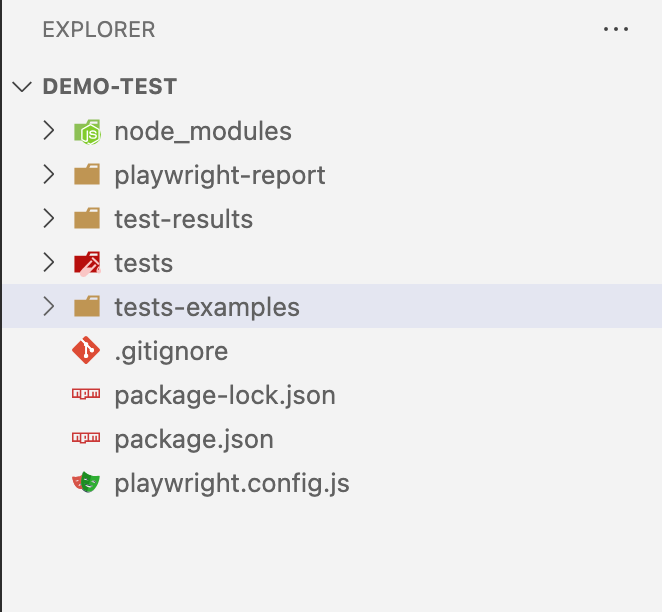
Running Test Scripts on Multiple Browsers
Now that we are all set, let’s find out how we can run the test scripts on multiple browsers at once in our Playwright cross-browser testing tutorial.
Step 1:
Open the playwright.config.js file in the project structure. Ensure that different browsers are configured by default in the playwright.config.js file.
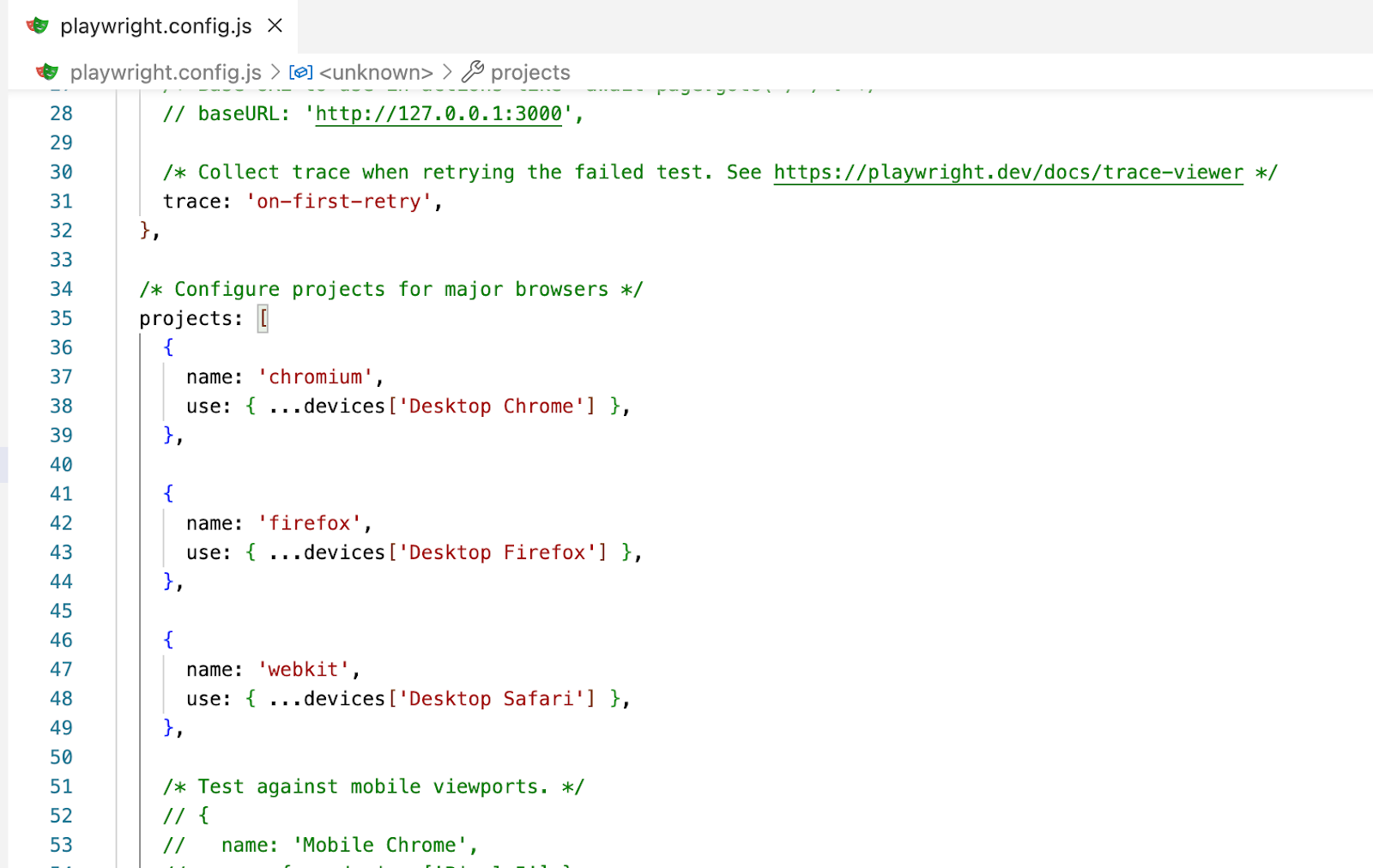
Step 2:
Run an example test in the tests folder using the below command
It will execute the tests in different browsers that are configured in the playwright.config.jsfile.

Step 3:
After the tests have been executed, you can see the report by executing the following command
<npx playwright show-report>
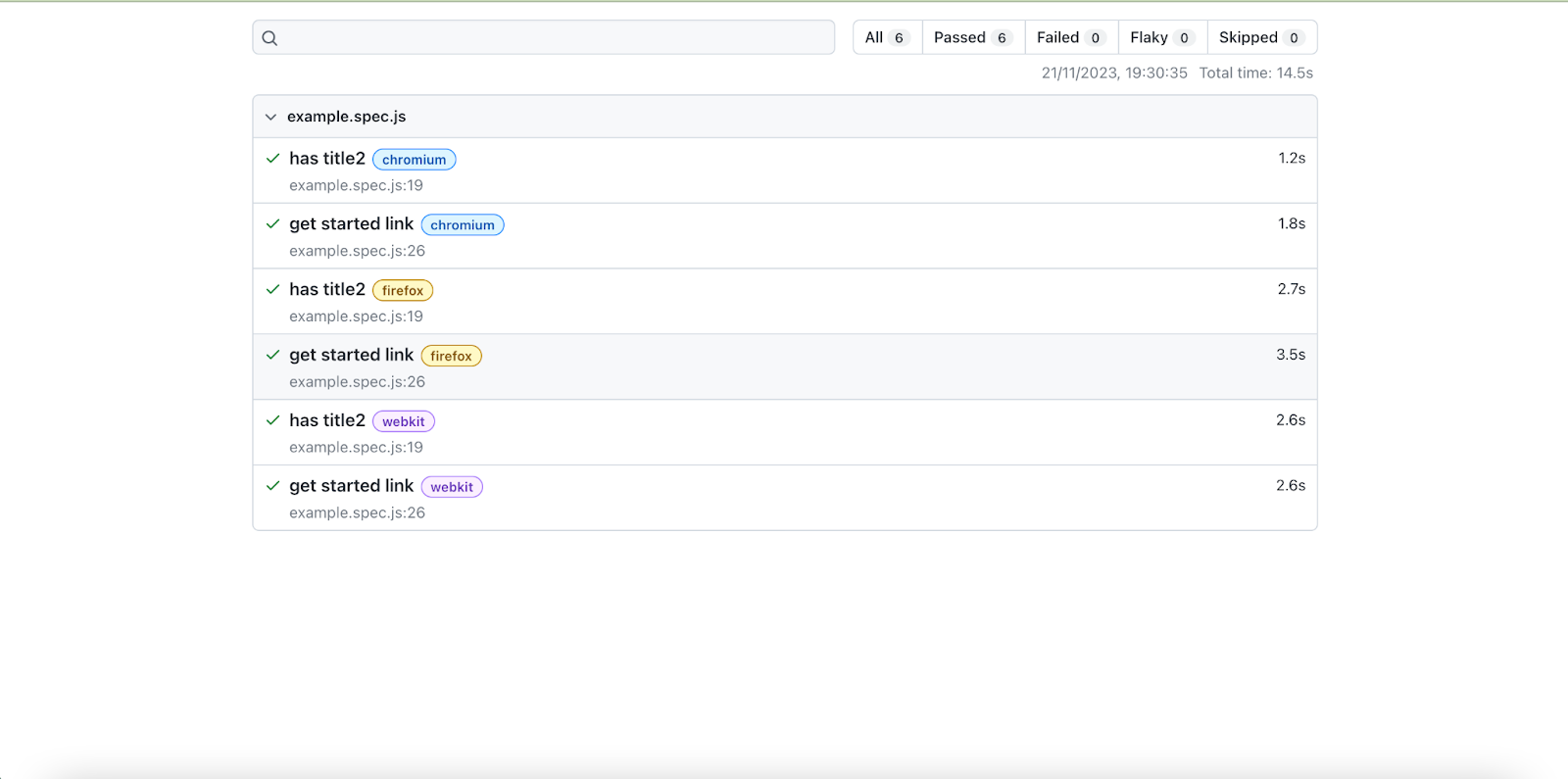
Running Test Scripts in a Particular Browser
Apart from running the test scripts in multiple browsers, you’ll also face the need to run your test scripts on a particular browser. And that is what we’ll be covering now in our Playwright cross-browser testing tutorial.
Chrome:
Run the below command to execute the tests in the Chrome browser
<npx playwright test --project=chromium>

You can view the report by executing the below command
<npx playwright show-report>

Firefox:
Run the below command to execute the tests in the Firefox browser
<npx playwright test --project=firefox>

You can view the report by executing the specified command
<npx playwright show-report>

Safari:
Run the below command to execute the tests in the Safari browser
<npx playwright test --project=webkit>

You can view the report by executing the mentioned command
<npx playwright show-report>

Alternate approach to run the test in different browsers
There is also an alternative approach you can follow to achieve Playwright Cross-browser testing. All you have to do is Click on TEST EXPLORER -> Click the drop down icon on the Run Test button. Here you will find different browsers to execute the test.
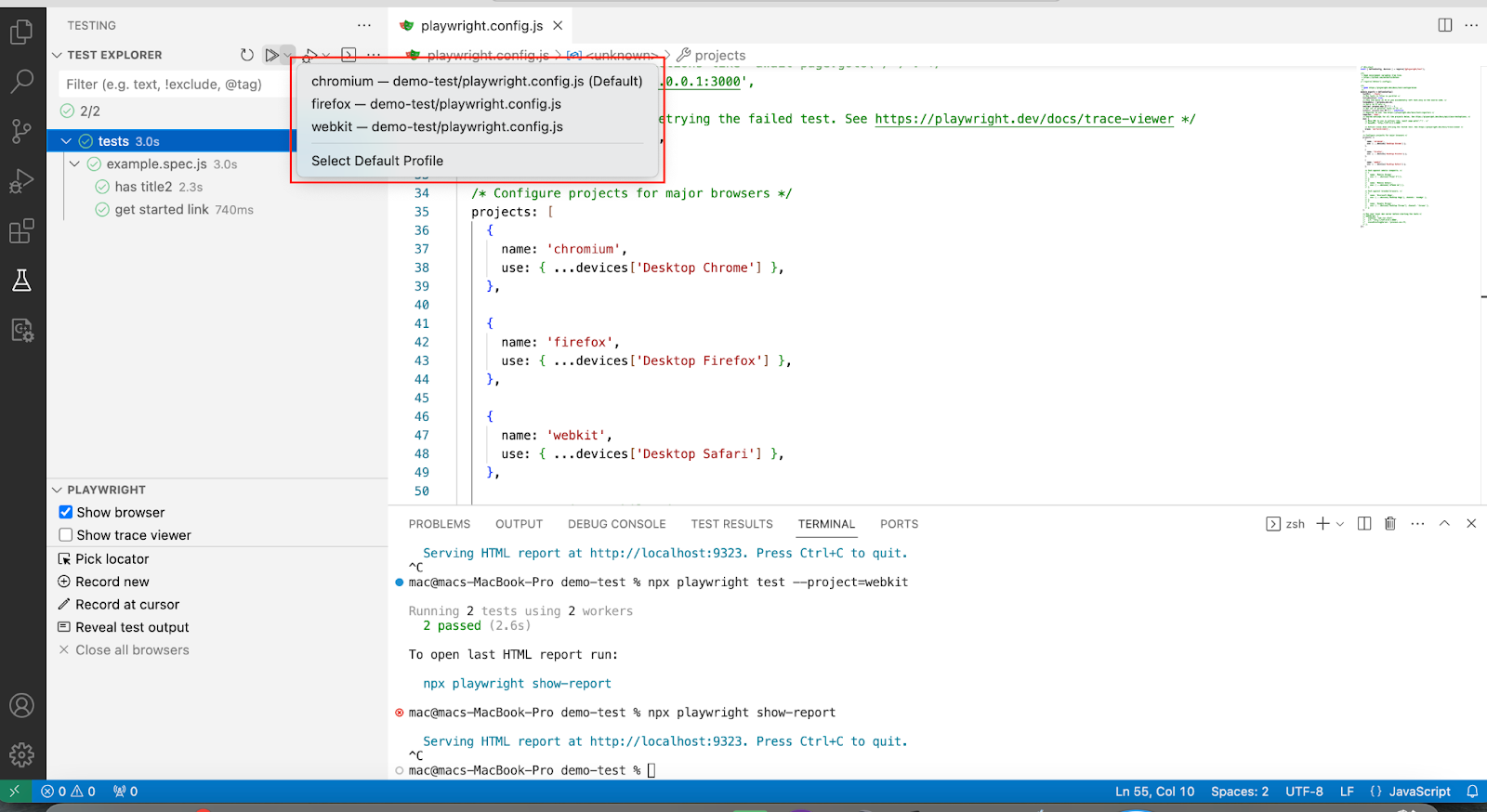
If you click on any of the browsers listed, the test will be executed on that particular browser. We can also change the default browser by clicking the Select Default Profile and choosing the default browser from the list.
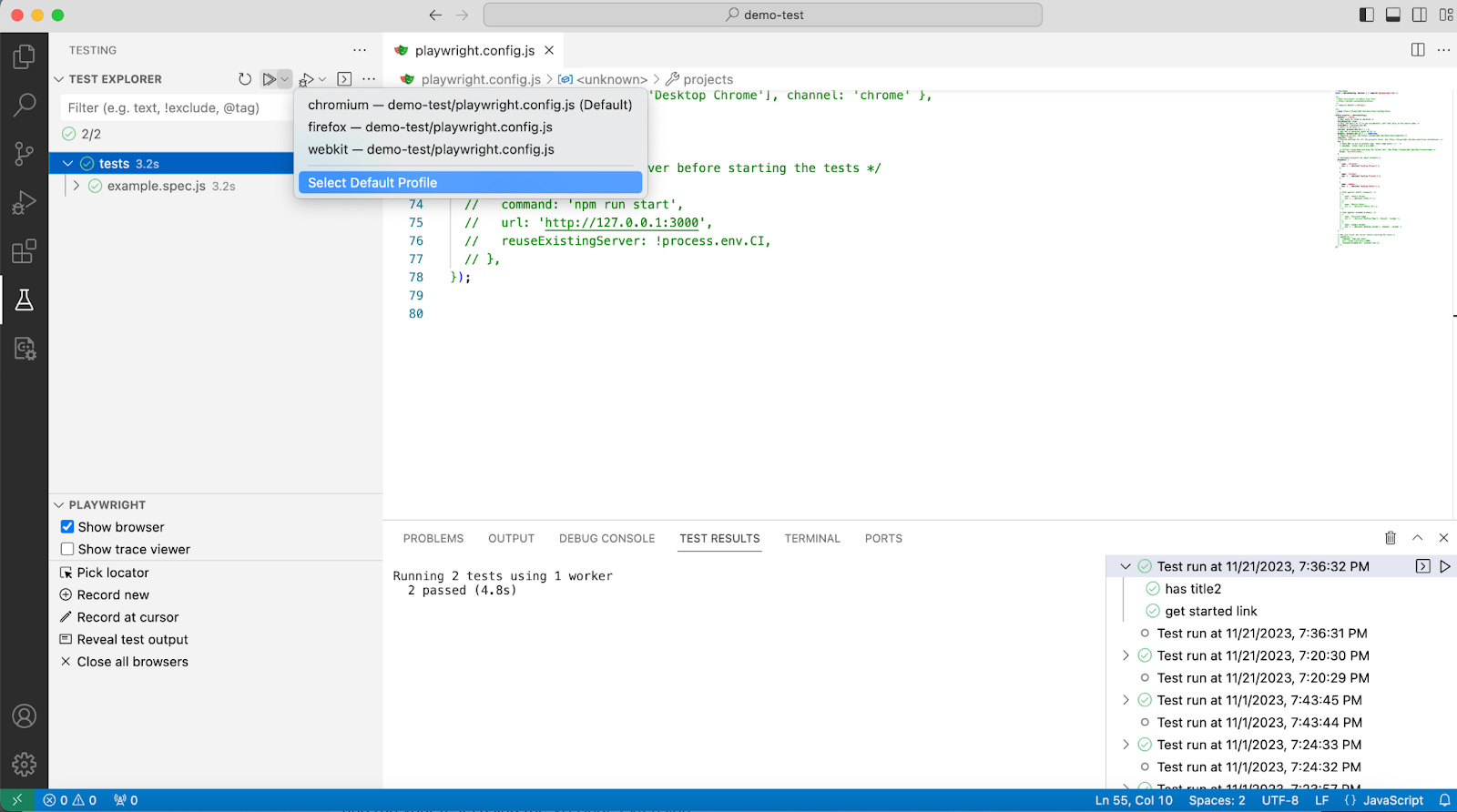
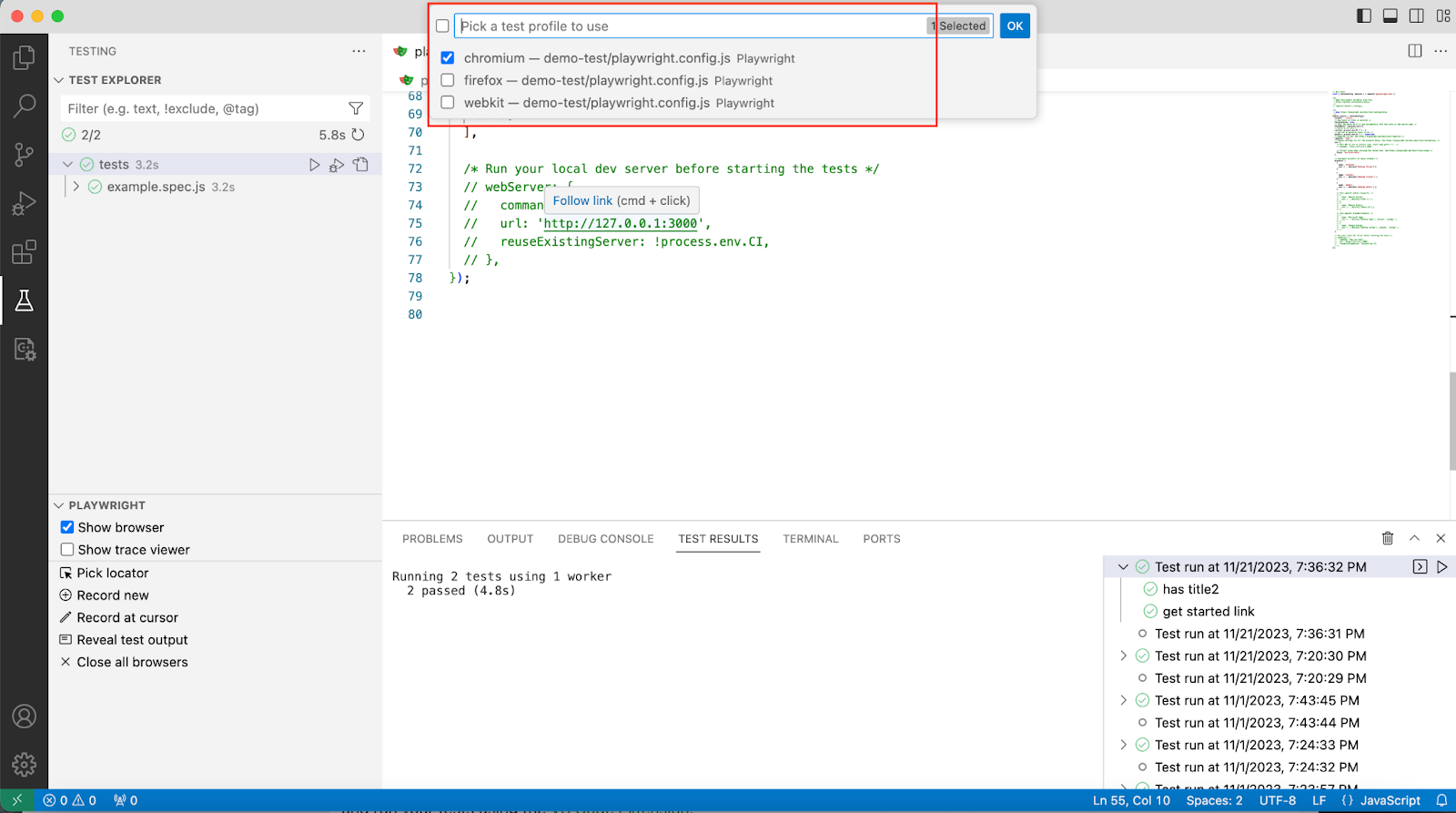
Launching Different Browsers using Code
Playwright supports testing on Chromium, Firefox, and WebKit-powered browsers. You can launch different browsers by importing the respective browser classes from Playwright:
<const { chromium, firefox, webkit } = require("playwright");>
To launch a specific browser, use the launch() method:
<const browser = await chromium.launch();>
Replace Chromium with Firefox or Webkit to launch Firefox or WebKit browsers.
Creating a Cross-Browser Testing Function
Now that we know how to launch different browsers, let’s create a function that accepts a website URL and tests it across multiple browsers in our Playwright cross-browser testing tutorial. This function launches each browser, navigates to the specified website URL, and runs the tests or assertions.
<const { chromium, firefox, webkit } = require("playwright");
const testOnAllBrowsers = async (websiteUrl) => {
const browsers = [chromium, firefox, webkit];
for (const browserType of browsers) {
const browser = await browserType.launch();
const context = await browser.newContext();
const page = await context.newPage();
await page.goto(websiteUrl);
// Perform your tests/assertions here
// ...
await browser.close();
}
};
>
Note: Remember to close the browser using browser.close() after you finish your tests.
Conclusion
Playwright offers a seamless way to assess the website’s performance across various browsers and viewport dimensions. Through the automation capabilities and advanced features provided by Playwright, you can streamline the testing procedure, guaranteeing a uniform user experience and identifying potential issues early in the development cycle. We hope you now have a clear understanding of how to perform Playwright cross-browser testing and found value in reading our blog. Stay connected to our space for more such informative software testing content.

by Mollie Brown | Mar 16, 2023 | Automation Testing, Blog |
In our Allure Report Tutorial, we will be explaining the steps to generate an Allure report and show you the different features that are available as reporting is an integral part of every automation testing framework. Without proper reports, you will not be able to analyze the results of your execution and take further action. Though automation tests are created and executed by people with technical knowledge, the people who read the reports may not possess too much technical knowledge. So it is important for reports to be visually strong and easy to understand.
We have chosen Allure as it is an open-source test reporting tool that can be used to represent the results of your test execution concisely in the form of interactive and comprehensive web reports. We also have first-hand experience in using Allure reports to create top-notch reports while delivering high-quality automation testing services to our clients. So using that experience, we have created and used a sample report in our Allure Report tutorial to make it easier for you to understand.
Allure Report Tutorial
You’d have to follow the below-mentioned installation steps if you haven’t yet installed Allure on your computer. If you already have Allure installed and are aware of the dependencies, you can directly proceed further in our Allure Report Tutorial. We have listed the important annotations you’ll have to know, defined the project structure, and provided the code snippets you can use to create your Allure report.
Installation & Set up
1. Download the latest version as a zip archive from Github Releases.
2. Unpack the archive to the allure-commandline directory.
3. Navigate to the bin directory.
4. Use allure.bat for Windows or allure for Unix platforms.
5. Add allure to the system PATH.
Note: Allure CLI requires Java Runtime Environment to be installed.
Add the Dependencies & Run
- Update the Properties section in the Maven pom.xml file
- Add Selenium, JUnit4 and Allure-JUnit4 dependencies in POM.xml
- Update Build Section of pom.xml in Allure Report Project.
- Create Pages and Test Code for the pages
Once you have completed all the above steps, you can run the test and generate your Allure Report by following the steps mentioned later on in our Allure report tutorial. Now let’s take a look at the code for your POM.xml file.
Pom.xml
<?xml version="1.0" encoding="UTF-8"?>
<project xmlns="http://maven.apache.org/POM/4.0.0"
xmlns:xsi="http://www.w3.org/2001/XMLSchema-instance"
xsi:schemaLocation="http://maven.apache.org/POM/4.0.0 http://maven.apache.org/xsd/maven-4.0.0.xsd">
<modelVersion>4.0.0</modelVersion>
<groupId>org.example</groupId>
<artifactId>Selenium-Allure-Demo</artifactId>
<version>1.0-SNAPSHOT</version>
<properties>
<project.build.sourceEncoding>UTF-8</project.build.sourceEncoding>
<selenium.version>3.141.59</selenium.version>
<testng.version>7.4.0</testng.version>
<allure.testng.version>2.14.0</allure.testng.version>
<maven.compiler.plugin.version>3.5.1</maven.compiler.plugin.version>
<maven.compiler.source>8</maven.compiler.source>
<maven.compiler.target>8</maven.compiler.target>
<aspectj.version>1.9.6</aspectj.version>
<maven.surefire.plugin.version>3.0.0-M5</maven.surefire.plugin.version>
</properties>
<build>
<plugins>
<!-- Compiler plug-in -->
<plugin>
<groupId>org.apache.maven.plugins</groupId>
<artifactId>maven-compiler-plugin</artifactId>
<version>${maven.compiler.plugin.version}</version>
<configuration>
<source>${maven.compiler.source}</source> <!--For JAVA 8 use 1.8-->
<target>${maven.compiler.target}</target> <!--For JAVA 8 use 1.8-->
</configuration>
</plugin>
<!-- Added Surefire Plugin configuration to execute tests -->
<plugin>
<groupId>org.apache.maven.plugins</groupId>
<artifactId>maven-surefire-plugin</artifactId>
<version>${maven.surefire.plugin.version}</version>
<configuration>
<suiteXmlFiles>
<suiteXmlFile>TestNG.xml</suiteXmlFile>
</suiteXmlFiles>
<argLine>
-javaagent:"${settings.localRepository}/org/aspectj/aspectjweaver/${aspectj.version}/aspectjweaver-${aspectj.version}.jar"
</argLine>
</configuration>
<dependencies>
<!-- https://mvnrepository.com/artifact/org.aspectj/aspectjweaver -->
<dependency>
<groupId>org.aspectj</groupId>
<artifactId>aspectjweaver</artifactId>
<version>${aspectj.version}</version>
</dependency>
</dependencies>
</plugin>
</plugins>
</build>
<dependencies>
<!-- https://mvnrepository.com/artifact/org.seleniumhq.selenium/selenium-java -->
<dependency>
<groupId>org.seleniumhq.selenium</groupId>
<artifactId>selenium-java</artifactId>
<version>${selenium.version}</version>
</dependency>
<!-- https://mvnrepository.com/artifact/org.testng/testng -->
<dependency>
<groupId>org.testng</groupId>
<artifactId>testng</artifactId>
<version>${testng.version}</version>
<scope>test</scope>
</dependency>
<!-- https://mvnrepository.com/artifact/io.qameta.allure/allure-testng -->
<dependency>
<groupId>io.qameta.allure</groupId>
<artifactId>allure-testng</artifactId>
<version>${allure.testng.version}</version>
<scope>test</scope>
</dependency>
</dependencies>
</project>
Project structure with Allure Report:
In our Allure report tutorial, we have basically kept two packages called ‘pages’ and ‘tests’. The pages package will include all the pages you want to test and the tests package will include the different tests that you want to perform.
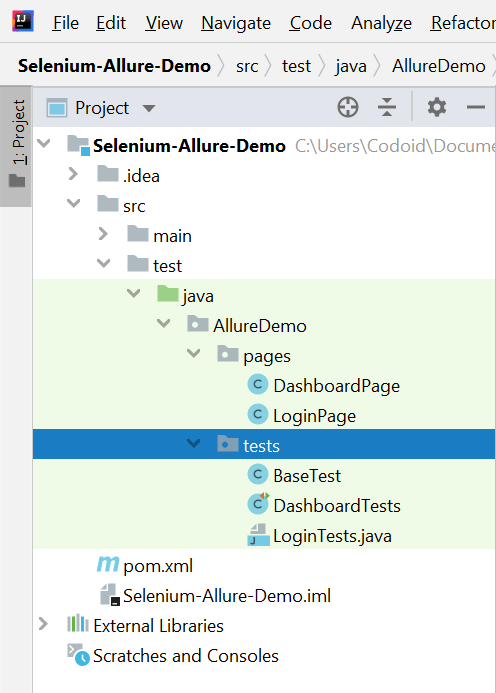
Pages Package:
There are two pages that we have added to our package, and they are the Dashboard page and the Login page.
Dashboard page:
package AllureDemo.pages;
import io.qameta.allure.Step;
import org.openqa.selenium.By;
import org.openqa.selenium.WebDriver;
import org.testng.Assert;
public class DashboardPage {
WebDriver driver;
By dashboardPageTitle = By.xpath("(//span[.='Dashboard'])[1]");
By options = By.xpath(
"//div[@title='Assign Leave']");
public DashboardPage(WebDriver driver) {
this.driver = driver;
}
@Step("Verify title of Dashboard page")
public void verifyDashboardPageTitle() {
String DashboardPageTitle = driver.findElement(dashboardPageTitle).getText();
Assert.assertTrue(DashboardPageTitle.contains("Dashboard"));
}
@Step("Verify Quick Launch Options on Dashboard page")
public void verifyQuickLaunchOptions() {
String QuickLaunchOptions = driver.findElement(options).getAttribute("title");
Assert.assertTrue(QuickLaunchOptions.contains("Assign Leave"));
}
}
Login page:
package AllureDemo.pages;
import io.qameta.allure.Step;
import org.openqa.selenium.By;
import org.openqa.selenium.WebDriver;
import org.testng.Assert;
public class LoginPage {
WebDriver driver;
By userName = By.name("username");
By password = By.name("password");
By titleText = By.name("username");
By login = By.xpath("//button[@type='submit']");
By errorMessage = By.xpath("//p[.='Invalid credentials']");
public LoginPage(WebDriver driver) {
this.driver = driver;
}
// Set user name in the textbox
public void setUserName(String strUserName) {
driver.findElement(userName).sendKeys(strUserName);
}
// Set password in the password textbox
public void setPassword(String strPassword) {
driver.findElement(password).sendKeys(strPassword);
}
// Click the login button
public void clickLogin() {
driver.findElement(login).click();
}
@Step("Verify title of Login Page")
public void verifyPageTitle() {
String loginPageTitle = driver.findElement(titleText).getAttribute("name");
Assert.assertTrue(loginPageTitle.contains("username"));
}
/* Failed Test */
@Step("Verify error message when invalid credentail is provided")
public void verifyErrorMessage() {
String invalidCredentialErrorMessage = driver.findElement(errorMessage).getText();
Assert.assertTrue(invalidCredentialErrorMessage.contains("Invalid credentials"));
}
@Step("Enter username and password")
public void login(String strUserName, String strPasword) {
// Fill in the user name
this.setUserName(strUserName);
// Fill in the password
this.setPassword(strPasword);
// Click the Login button
this.clickLogin();
}
}
Tests Package:
For our Allure Report tutorial, we have added 3 tests by the names base test, dashboard test, and login test. Let’s take a look at the code snippets for each of these tests below.
Base test:
package AllureDemo.tests;
import AllureDemo.pages.DashboardPage;
import AllureDemo.pages.LoginPage;
import io.qameta.allure.Step;
import org.openqa.selenium.WebDriver;
import org.openqa.selenium.chrome.ChromeDriver;
import org.openqa.selenium.firefox.FirefoxDriver;
import org.testng.annotations.AfterClass;
import org.testng.annotations.AfterMethod;
import org.testng.annotations.BeforeClass;
import org.testng.annotations.BeforeMethod;
import java.util.concurrent.TimeUnit;
public class BaseTest {
public static WebDriver driver;
LoginPage objLogin;
DashboardPage objDashboardPage;
@Step("Start the application")
@BeforeMethod
public void setup() {
System.setProperty("webdriver.chrome.driver",
"C:\\Users\\Codoid\\Documents\\QA-SAM-March2023-Stories\\resources\\drivers\\chromedriver_win.exe");
driver = new ChromeDriver();
driver.manage().window().maximize();
driver.manage().timeouts().implicitlyWait(10, TimeUnit.SECONDS);
driver.get("https://opensource-demo.orangehrmlive.com/");
}
@Step("Stop the application")
@AfterMethod
public void close() {
driver.close();
}
}
DashboardTests
package AllureDemo.tests;
import AllureDemo.pages.DashboardPage;
import AllureDemo.pages.LoginPage;
import io.qameta.allure.*;
import org.testng.ITestNGListener;
import org.testng.annotations.Listeners;
import org.testng.annotations.Test;
@Epic("Web Application Regression Testing")
@Feature("Dashboard Page Tests")
@Listeners(TestExecutionListener.class)
public class DashboardTests extends BaseTest {
LoginPage objLogin;
DashboardPage objDashboardPage;
@Severity(SeverityLevel.BLOCKER)
@Test(priority = 0, description = "Verify Dashboard Page")
@Description("Test Description : After successful login to application opens Dashboard page")
@Story("Successful login of application opens Dashboard Page")
public void DashboardTest() {
objLogin = new LoginPage(driver);
// Login to the application
objLogin.login("Admin", "admin123");
// Go to the dashboard page
objDashboardPage = new DashboardPage(driver);
// Verify the dashboard page
objDashboardPage.verifyQuickLaunchOptions();
}
private class TestExecutionListener implements ITestNGListener {
}
}
LoginTests
package AllureDemo.tests;
import AllureDemo.pages.DashboardPage;
import AllureDemo.pages.LoginPage;
import io.qameta.allure.*;
import org.testng.annotations.Listeners;
import org.testng.annotations.Test;
@Epic("Regression Tests")
@Feature("Login Tests")
@Epic("Web Application Regression Testing")
@Feature("Login Page Tests")
@Listeners(TestExecutionListener.class)
public class LoginTests extends BaseTest {
LoginPage objLogin;
DashboardPage objDashboardPage;
@Severity(SeverityLevel.NORMAL)
@Test(priority = 0, description = "Verify Login Page")
@Description("Test Description : Verify the title of Login Page")
@Story("Title of Login Page")
public void verifyLoginPage() {
// Create Login Page object
objLogin = new LoginPage(driver);
// Verify login page text
objLogin.verifyPageTitle();
}
/* Failed Test */
@Severity(SeverityLevel.BLOCKER)
@Test(priority = 1, description = "Login with invalid username and password")
@Description("Test Description : Login Test with invalid credentials")
@Story("Unsuccessful Login to Application")
public void invalidCredentialTest() {
// Create Login Page object
objLogin = new LoginPage(driver);
objLogin.login("test", "test123");
// Verify login page text
objLogin.verifyErrorMessage();
}
}
TestExecutionListener
package AllureDemo.tests;
import io.qameta.allure.Attachment;
import org.openqa.selenium.OutputType;
import org.openqa.selenium.TakesScreenshot;
import org.openqa.selenium.WebDriver;
import org.testng.ITestListener;
import org.testng.ITestResult;
public class TestExecutionListener implements ITestListener {
@Attachment(value = "Screenshot of {0}", type = "image/png")
public byte[] saveScreenshot(String name, WebDriver driver) {
return (byte[]) ((TakesScreenshot) driver).getScreenshotAs(OutputType.BYTES);
}
@Override
public void onTestFailure(ITestResult result) {
saveScreenshot(result.getName(), BaseTest.driver);
}
}
TestNG XML
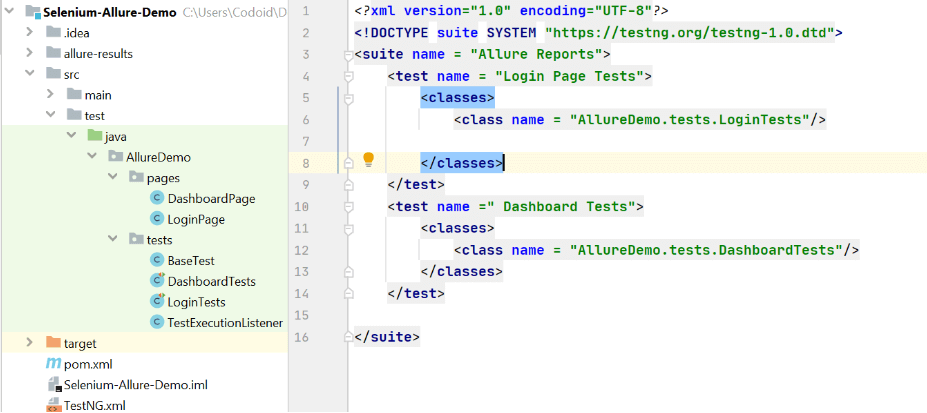
Test Execution
In order to execute your tests, you have to open command prompt, go to the project directory, and write the below command.
allure serve allure-results
Allure in Cucumber BDD
You can also add Allure to your Cucumber BDD framework by adding the below dependency in the POM.xml file.
<!-- https://mvnrepository.com/artifact/io.qameta.allure/allure-cucumber-jvm -->
<dependency>
<groupId>io.qameta.allure</groupId>
<artifactId>allure-cucumber6-jvm</artifactId>
<version>2.14.0</version>
</dependency>
</dependencies>
Add the following plugin to your Runner cukes file by referring to the below screenshot
"io.qameta.allure.cucumber6jvm.AllureCucumber6Jvm"
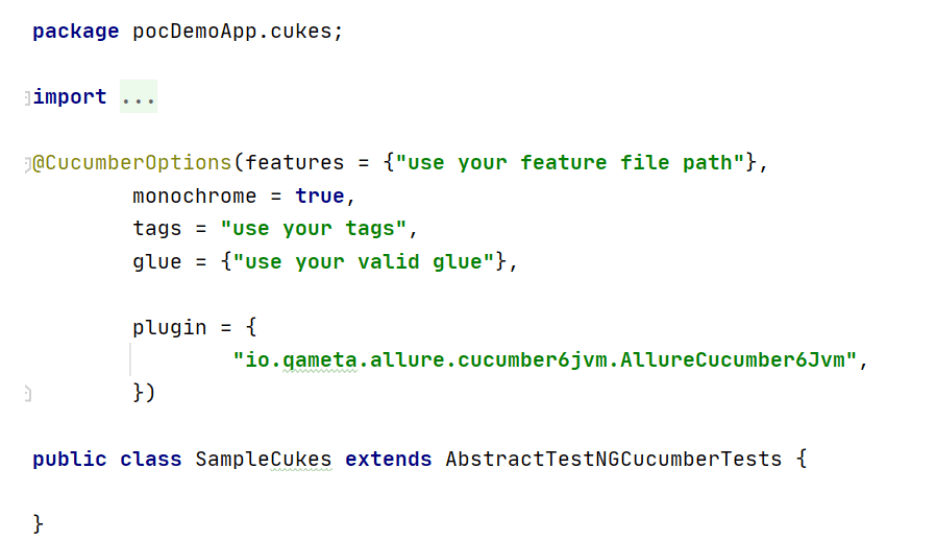
Sample Allure Report
Before we proceed to see the sample report in our Allure report tutorial, let’s first explore the 5 most important or commonly used annotations used in Allure. You can expand the capabilities of an Allure report by using more annotations, but these 5 will help you generate your basic first report.
Important Annotations used in the Allure report
- @Step – This annotation is used as a step definition to define any modifier with the parameter.
- @Epic – This annotation is used to define the large component or a whole product under which the Allure depends on.
- @Feature – We can use it to represent all the possible test coverage options based on the Test scenarios.
- @Stories – Every Epic has many stories and each of those stories represent a sub-product or sub-component.
- @Attachment – At the end of our test execution, we will have to add screenshots to our reports. And this annotation can be used to define the position of the screenshot.
Allure Report Overview
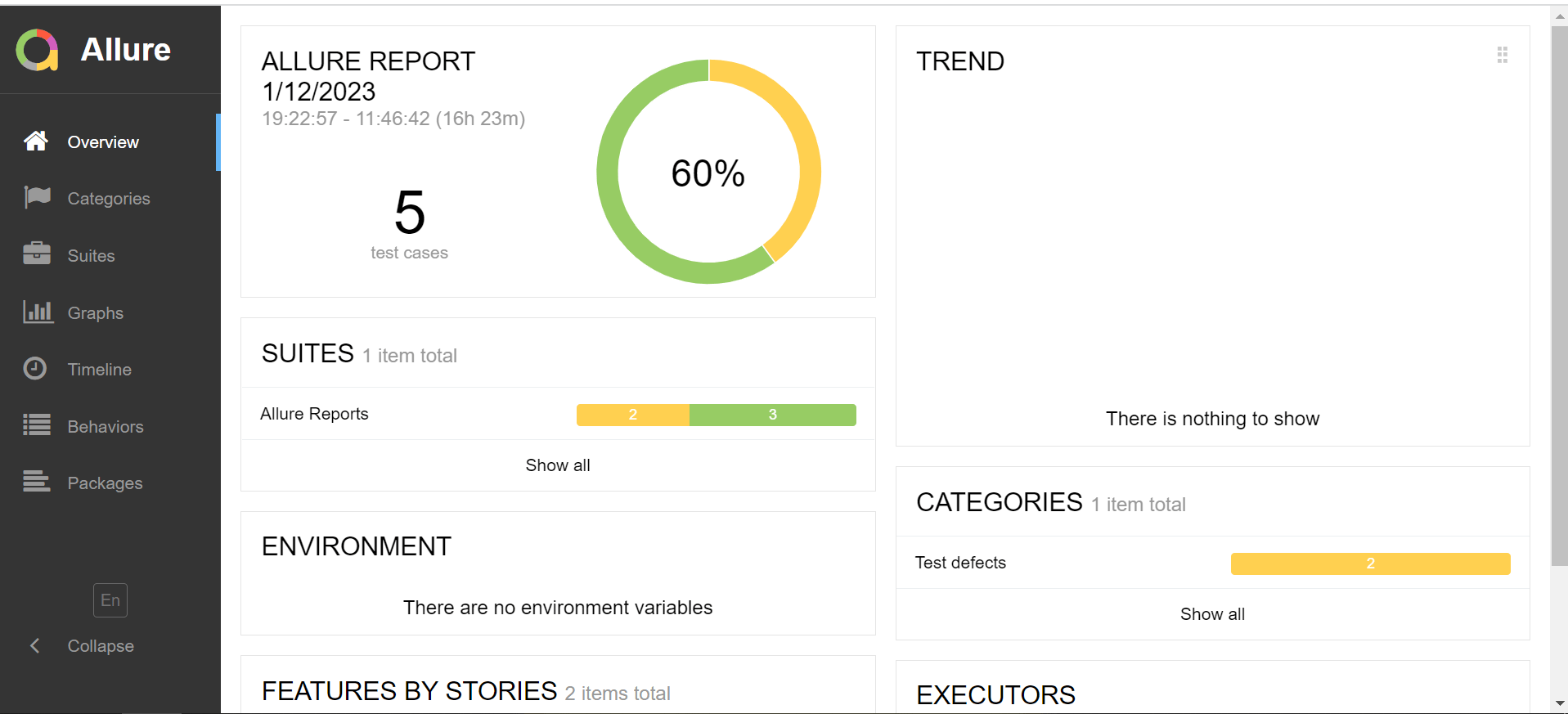
As you can see in the above screenshot, the Allure report overview has different sections such as suites, environment, categories, and so on. Let’s find out what they are in our Allure report tutorial.
Suites
A suite is a group of tests that share a common context such as a specific test environment or a particular test category. Suites are represented by colored blocks in the report’s timeline, and you can drill down into the details of each suite by clicking on them.
Environment:
The environment section contains information about the operating system, browser, framework, and version of the tools used.
Features By Stories:
In order to group test cases by features or user stories in an Allure report, you can use the @Feature or @Story annotations in your test code.
Categories:
Once this annotation is added to the test, the test cases will be grouped under the “smoke” and “regression” categories when your Allure report is generated. It is also possible to use the allure.category property to add the category information to the test case.
Executors:
Allure also supports custom executors that can be used when your current executors do not match the requirements of your project. Kindly note that they have to be implemented as a separate component.
Graphs:
Graphical representation of the status, severity, duration, and duration trend will also be available in an Allure report’s overview.
Timeline:
This section in an Allure report’s overview provides a graphical representation of the test execution. It will show the duration of each test case, and also specifies the order in which they were executed.
Categories in Allure Report
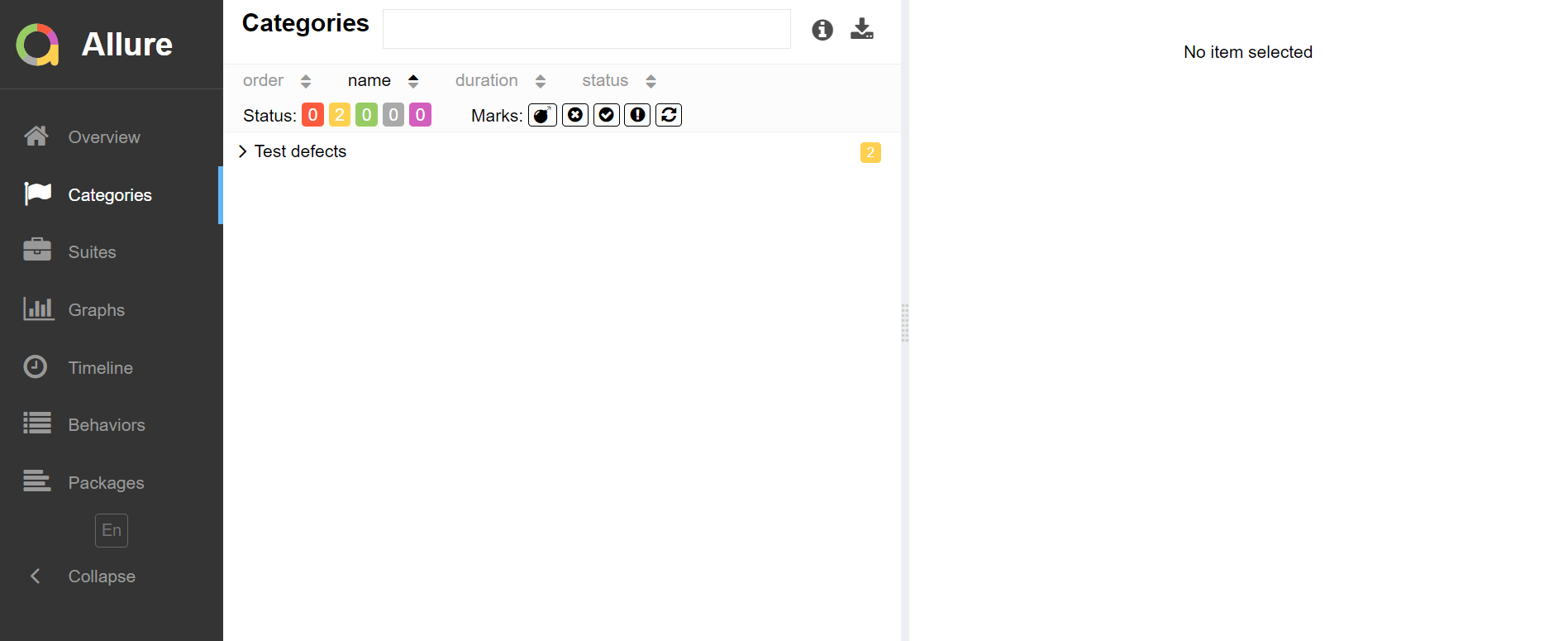
Next up in our Allure report tutorial, we’re going to explore the Categories tab that gives you the way to create custom defects classification for your test results.
By default, there will be two categories of defects in an Allure report:
- Product defects (Tests that failed due to an issue in the product)
- Test defects (Broken tests)
But you also have the option to create custom defect classifications such as skipped tests, outdated tests, and so on. You can do so by adding a categories.json file to the allure-results directory before report generation.
categories.json
[
{
"name": "Ignored tests",
"matchedStatuses": ["skipped"]
},
{
"name": "Infrastructure problems",
"matchedStatuses": ["broken", "failed"],
"messageRegex": ".*bye-bye.*"
},
{
"name": "Outdated tests",
"matchedStatuses": ["broken"],
"traceRegex": ".*FileNotFoundException.*"
},
{
"name": "Product defects",
"matchedStatuses": ["failed"]
},
{
"name": "Test defects",
"matchedStatuses": ["broken"]
}
]
(mandatory) category name
(optional) list of suitable test statuses. Default [“failed”, “broken”, “passed”, “skipped”, “unknown”]
(optional) regex pattern to check test error message. Default “.*”
(optional) regex pattern to check stack trace. Default “.*”
Test result falls into the category if their status is in the list and both the error message and stack trace match the pattern.
Suites in Allure Report
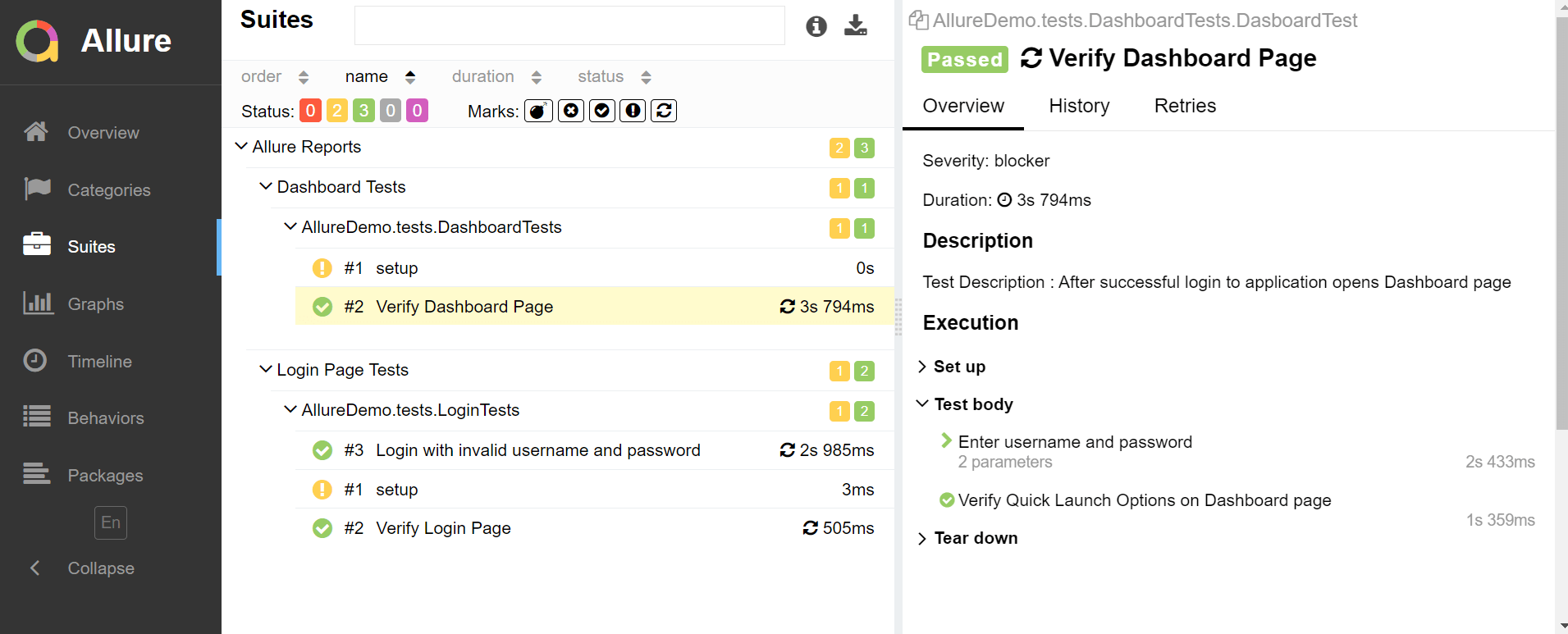
As you can see in the above screenshot, the Suites tab shows a standard structural representation of the executed tests, grouped by the suites and classes that can be found.
Graphs in Allure Report
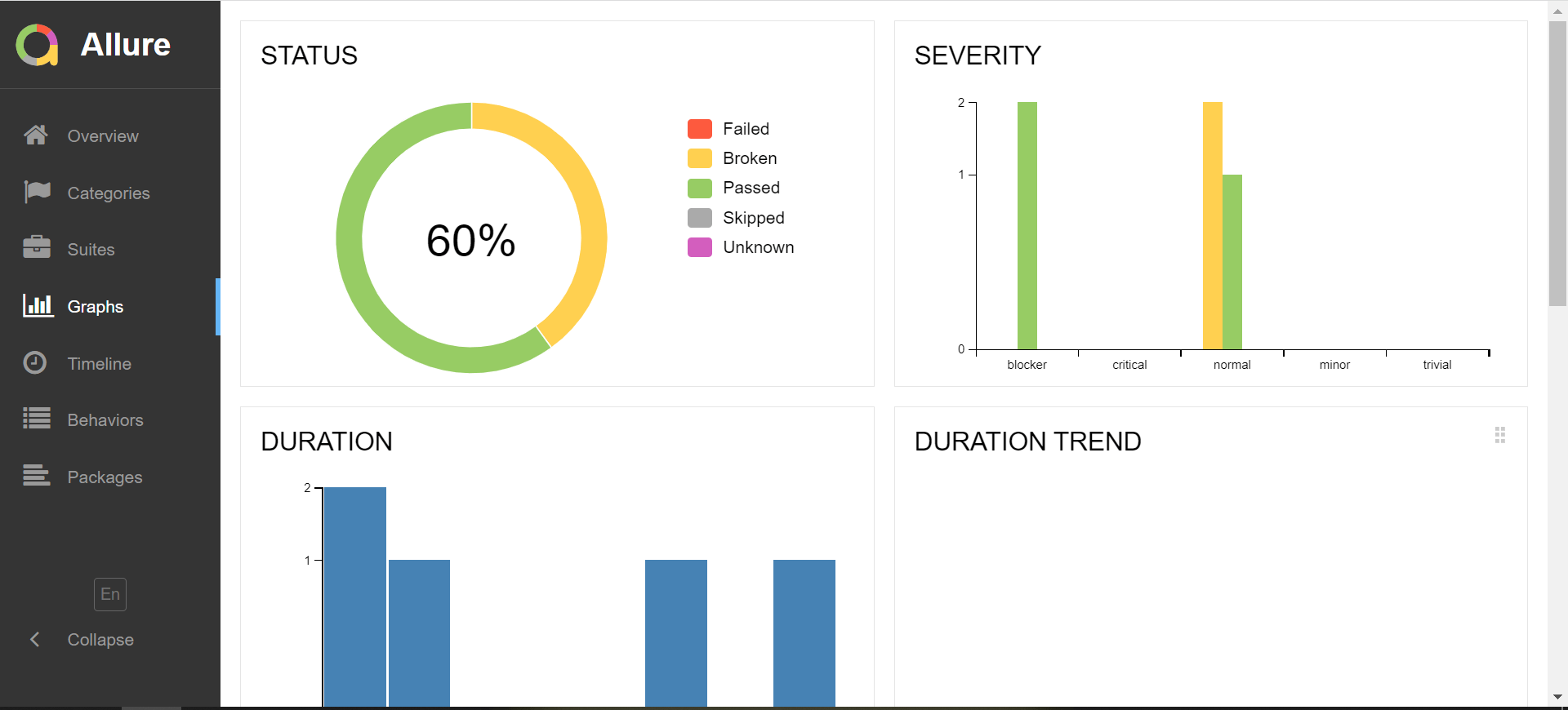
Graphs allow you to see different statistics collected from the test data such as status breakdown, severity, and duration diagrams. They will be very effective in helping us understand the status of our test execution easily.
Behaviors in Allure Report
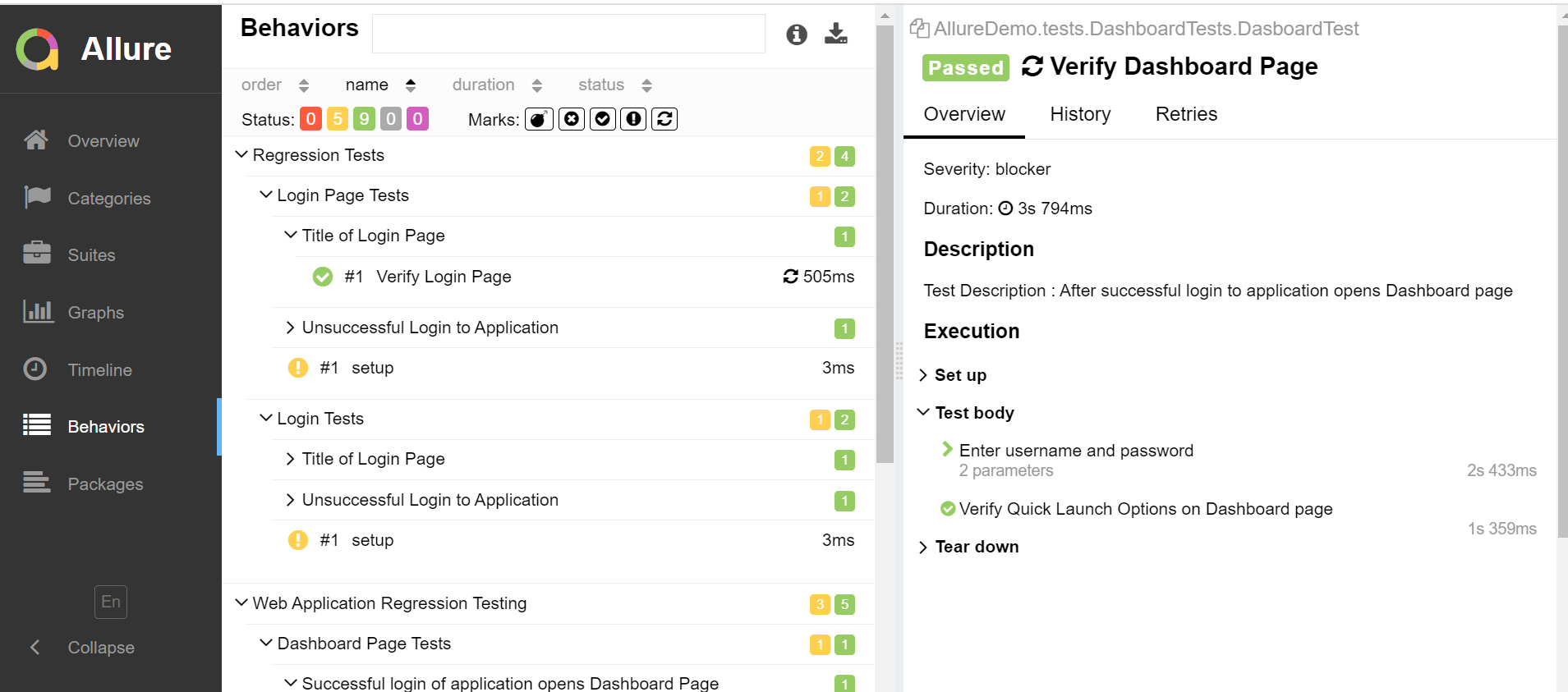
Behaviors group the test results according to Epic, Feature, and Story tags. It also consists of the status of each and every execution and has a detailed description as well.
Timeline in Allure Report
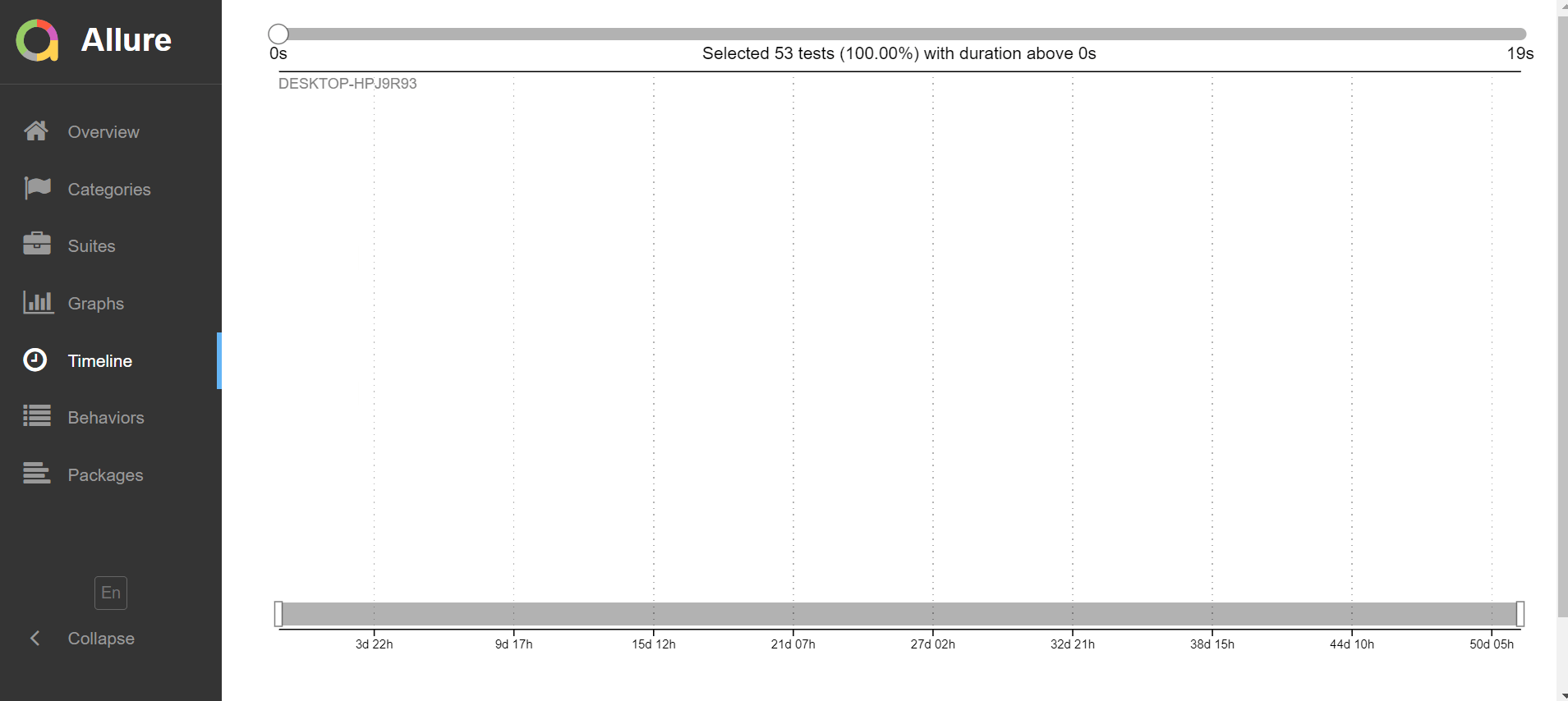
Allure adaptors will collect the accurate timings of the tests and arrange them in a sequential or parallel structure based on the timing. This visualization of the test execution will be available in the Timeline section of our Allure report.
Packages in Allure Report
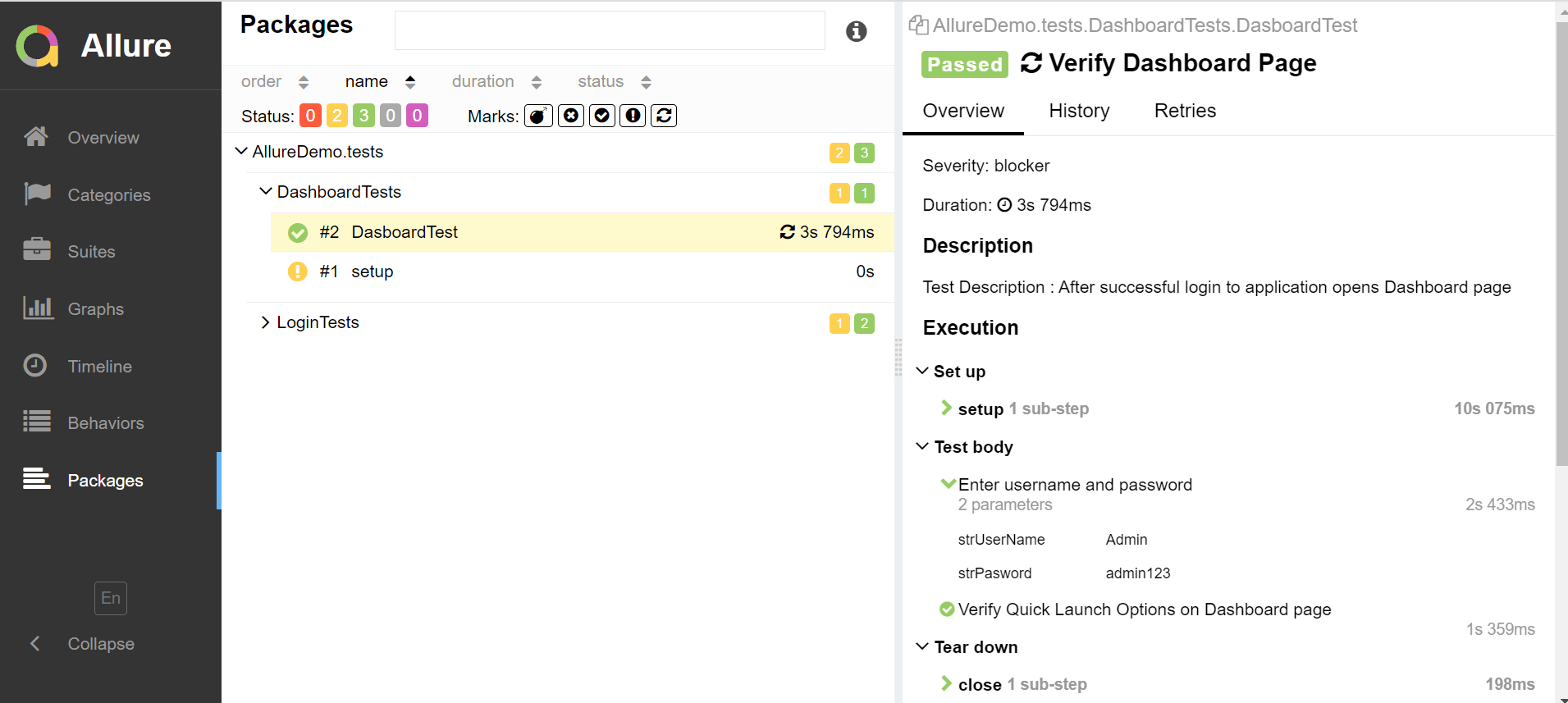
The packages tab represents a tree-like layout of the test results, grouped by different packages as shown in the above image.
Advantages of Allure Report
In general, effective reporting can help shorten the development/QA lifecycle by providing both the developers and testers with all the information they will need. As seen above in our Allure report tutorial, it enables us to categorize the test failures into bugs, broken tests, and logs. Other vital information such as steps, fixtures, attachments, timings, history, and integrations with TMSs are also available to configure bug-tracking systems.
Managers and stakeholders will have a clear understanding of the project’s big picture, progress, timeline, defects clustering info, and so on. Now let’s take a look at the technical advantages that Allure reports have to offer.
- Allure is an open-source report engine built using AngularJS.
- It supports various frameworks such as JUnit, TestNG, Cucumber-Java, Selenide, Pytest, behav, Jasmine, Mocha, RSpec, Spock, PHPUnit, SpecFlow, NUnit, MSTest, etc.
- You can create visually rich reports that can be easily understood even by non-technical team members such as Stakeholders and Business Analysts.
- It has a command line interface to generate reports based on maven surefire plugins.
- It supports popular CI/CD platforms like Jenkins, TeamCity, Banboo, Gradle, Maven, and CodeFresh.
- Modularity and extensibility of Allure guarantee that you will always be able to fine-tune it to make Allure suit your needs better.
Note: Allure allows you to generate a single HTML file for easy sharing and viewing of test reports.
Why Use a Single HTML File?
- Simplified Sharing: No additional setup is needed to view the report.
- Compact and Portable: All required data is packaged into a single, standalone file.
- Browser Compatibility: Open and view in any modern browser without additional dependencies.
Steps to generate single Html file :
Open cmd for framework location
enter “allure generate –single–file D:\QA\QA-test-automation-codoid-Feb21\allure-results”
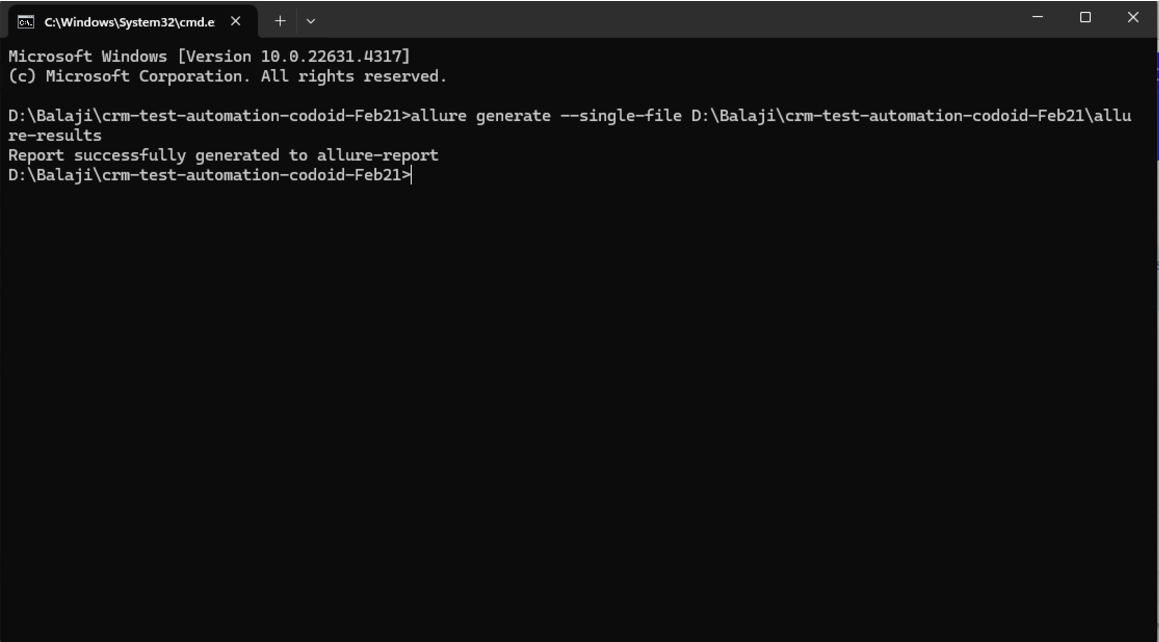
It will generate single html file in “allure-report” folder as below.

Conclusion
As a lightweight, flexible, multilingual test report tool, Allure Framework provides a neat web report that not only illustrates what has been tested in a concise manner. It also gives everyone involved in developing the maximum amount of useful information from testing every day. We hope that our Allure Report tutorial has given you a clear understanding of how to generate Allure reports for your project. As a leading automation testing company, we have also written a blog highlighting the key differences between Allure report and Extent report. So make sure to subscribe to our newsletter to not miss out on any of our latest blogs and updates.

by Hannah Rivera | Feb 23, 2023 | Automation Testing, Blog |
On average, more than 2 Billion people use Google Sheets on a monthly basis. It is a powerful tool for managing and analyzing data. It is a popular choice among individuals as it is very user-friendly in nature. Additionally, it is also widely used by professionals and businesses. With continuous & extensive usage, few tasks could end up becoming repetitive and time-consuming. But with the help of automation, you will be able to overcome this major issue and streamline your workflow and perform tasks more efficiently. Being an automation testing company, we have written this gspread Python tutorial to help you automate google sheets using Python. So let’s get started.
There are actually several libraries such as pygsheets, gdata, and gspread that one can use to automate Google Sheets using Python. And we have picked gspread for this particular tutorial. We’ll explore the basic setup & configuration required to get started, explore some common use cases, and then dive into how we can automate those use cases in Google Sheets using Python.
Google Sheet Automation Set up
Before we explore how to automate Google Sheets using Python in our gspread Python Tutorial, we’ll find out how to set up the prerequisites.
Install a Python library
We have chosen gspread for this tutorial as it is one of the most popular and widely used libraries. So the first step in our gspread Python Tutorial is to install the gspread library that is needed to achieve Google Sheets automation using Python.
You can install gspread using the below command,
Command:
Output:

Once you have installed the library, you’ll need to set up authentication. And to do that, you’ll have to create a “service account” in Google API Console and grant access to the Google Sheet you want to automate. Let’s see what steps have to be followed to do it.
Create a New Project
Navigate to Google Developers Console and click on ‘Create Project’.

For explanation purposes, we have created a project called ‘Gsheet Reader’ for our gspread Python Tutorial. You can also do it by filling in the required fields as shown in the below image and clicking the ‘Create’ button.
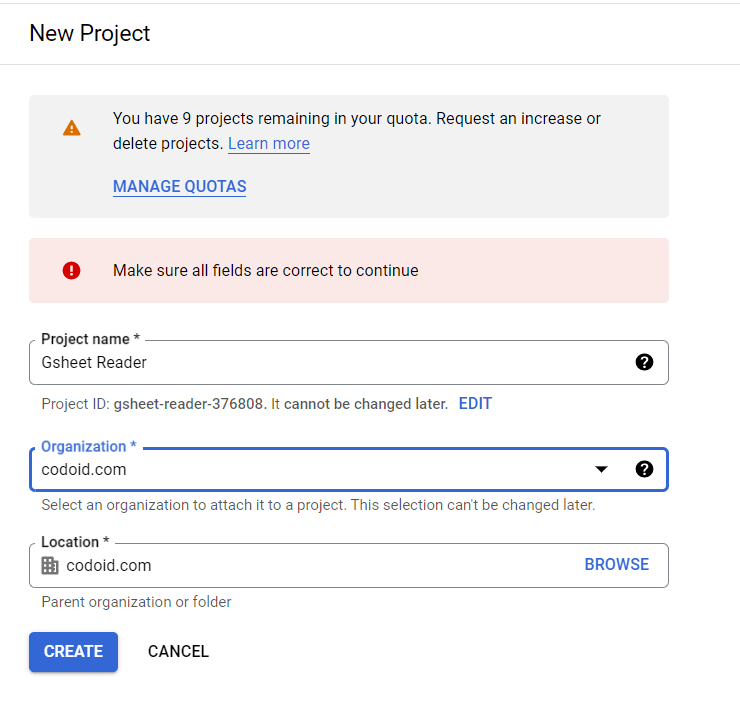
Enable API & Services
As the project has been created, you will see a new option to ‘Enable APIs and Services’ as shown below. You’ll have to click on it to add the Google Sheet API.

There will be a list of APIs and you can enter an appropriate keyword such as ‘sheet’ in the search bar and select the ‘Google Sheets API’.

You can then click the ‘Enable’ button from the Product Details page.

Create Credentials:
Google Sheets API will now appear in your Enabled APIs & Services tab. You will see 3 sections namely Metrics, Quotas, and Credentials under it. So the next step in our gspread Python Tutorial would be to see how to create the required credentials to access the Google Sheet API.
So click the ‘Create Credentials’ button and follow the below steps.
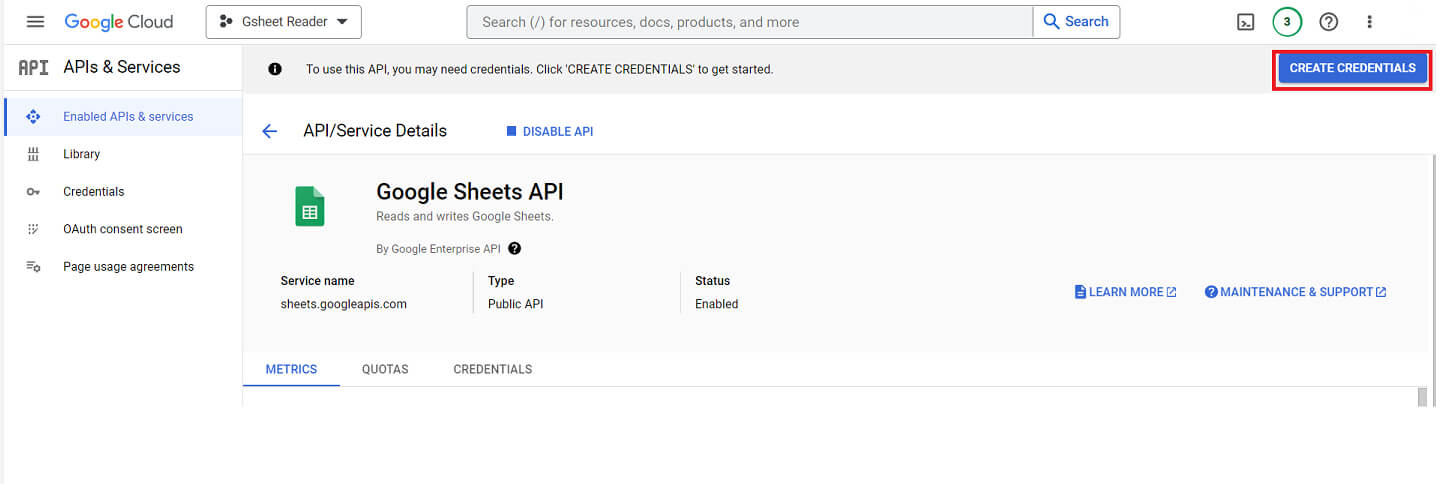
Credential Type
- Select ‘Google Sheets API’ in the ‘Select an API’ drop-down
- Select the ‘Application Data’ radio button, and
- Choose the ‘No, I’m not using them’ option in the last question.
- Click ‘NEXT’.

Service Account Details
After which, you’ll have to enter the Service account name & Service account ID in the respective fields and click the ‘CREATE AND CONTINUE’ button.
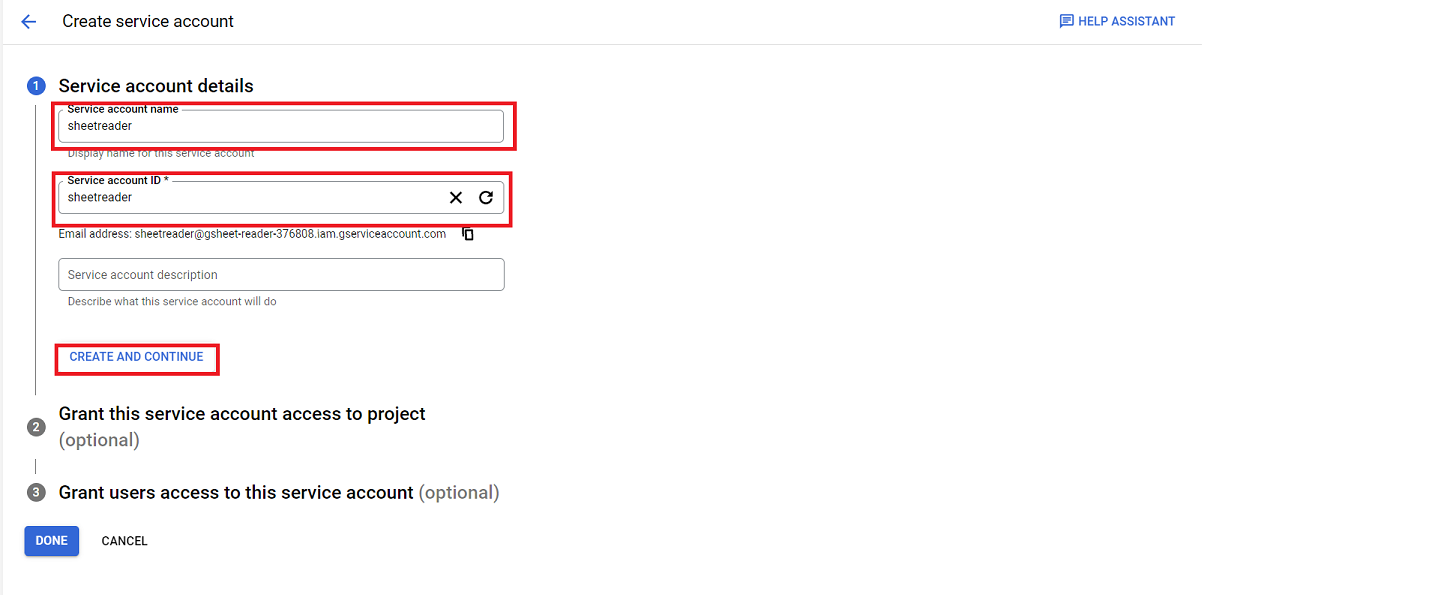
Grant Access
Now, you’ll have to specify the level of access you are going to provide for the service account.
Click on ‘Select a Role’ and select ‘Editor’ under the ‘Basic’ section. Based on your needs, you can choose whichever role will be the aptest.
Press ‘CONTINUE’ and leave the other optional fields and click DONE.

You will now be able to see the newly created Service account under the Credentials section.
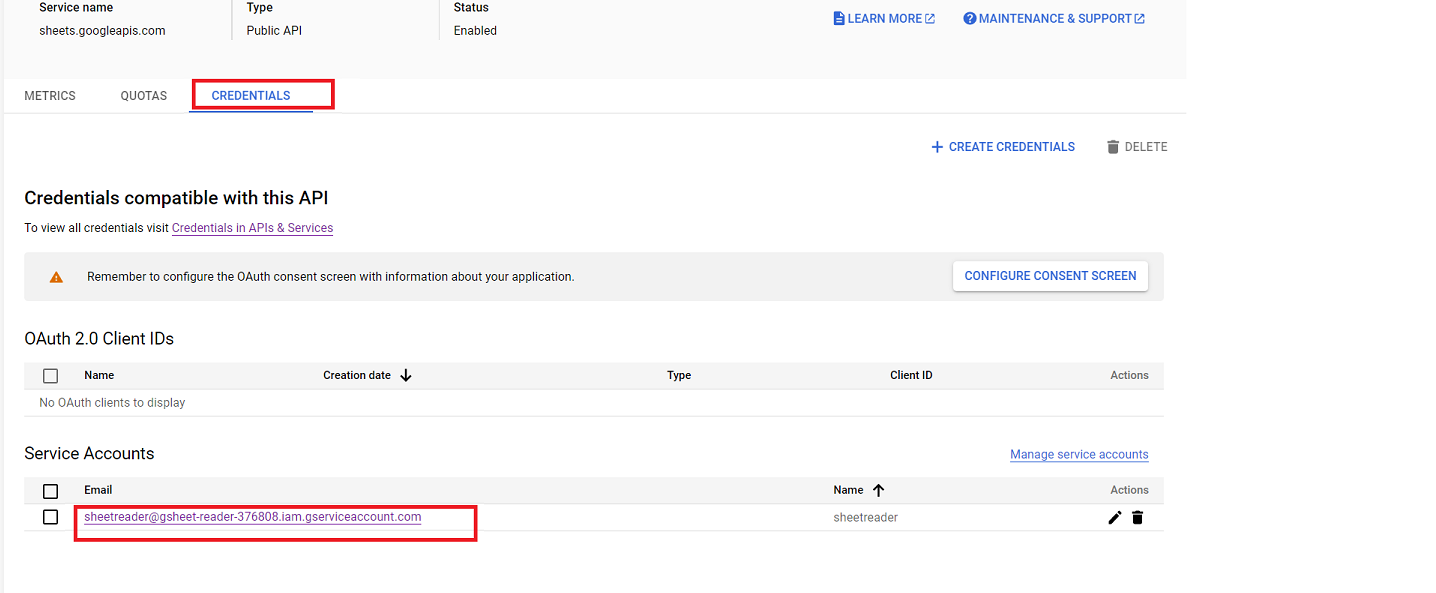
Under the Keys Section, you can click on ‘ADD KEY’ and choose ‘Create new key’ to create a credential secret key.
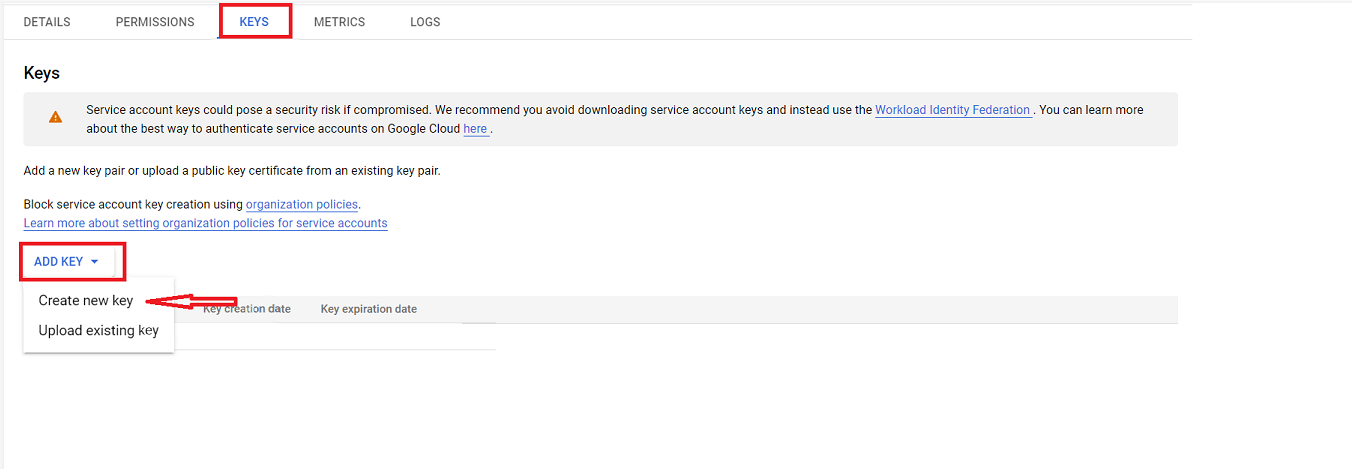
There are two key types, and as suggested by Google, it is better to choose the JSON key type. After making the selection, click the ‘CREATE’ button.
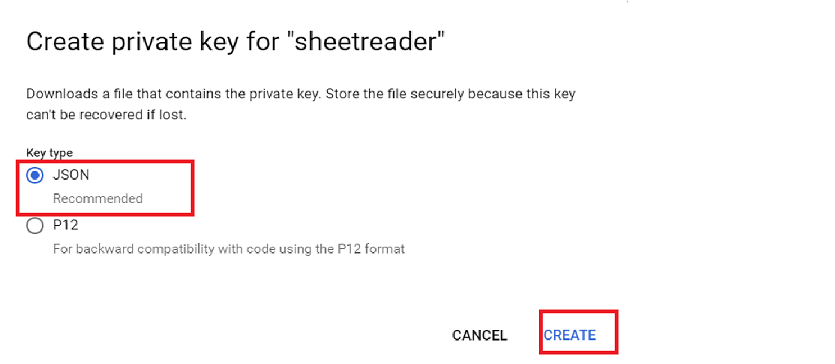
Once you click the button, the key will be downloaded to your computer. Please make sure to not share this file with anyone else and keep it safe.
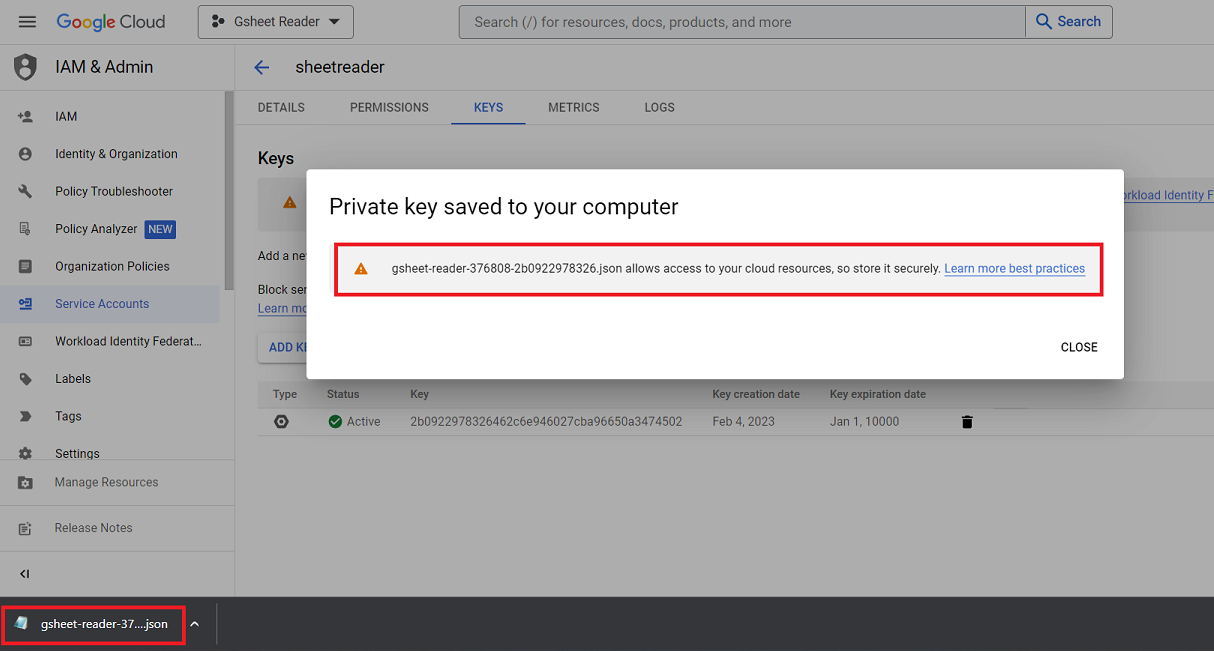
Tip: It will be helpful if you rename the file to credentials.json as it will be easy for you to remember the file name.
Create a Google Sheet
So the last step in our setup process is to create a Google Sheet that we can use to store our data. Once we are clear with that, we can go ahead and see the different Python code commands you can use to perform Google Sheet Automation.
If you already have a Google sheet, you can just copy the sheet url or sheet id as shown in the image as this copied string will be needed to access Google Sheets.

gspread Python Tutorial
Everything you’ll need to achieve Google Sheet Automation is now ready. So you can start automating the listed actions by typing the Python code commands we have mentioned in a code editor.
Opening a Spreadsheet
First up in our gspread Python Tutorial, we’ll be seeing how to open a spreadsheet using Python code commands. Remember the URL we had copied after creating a new Google Sheet? We will now use it to open that spreadsheet. You can also use your Sheet’s key to open the spreadsheet.
We will also have to use the JSON key we have created.
Code:
import gspread
Sheet_credential = gspread.service_account("credential.json")
# Open Spreadsheet by URL
# spreadsheet = Sheet_credential.open_by_url('paste your sheet url')
# Open Spreadsheet by key
spreadsheet = Sheet_credential.open_by_key('paste your sheet key')
print(spreadsheet.title)
Output:

You can see that the name of the Google Sheet we created (Gsheet Automation) has been fetched here.
Get a Worksheet’s Name
A Spreadsheet can have more than one worksheet and if you wish to print the name and ID of a worksheet, you can use the below Python code commands.
Code:
# to print worksheet name using sheet id
worksheet = spreadsheet.get_worksheet(0)
# to print worksheet name using sheet name
worksheet = spreadsheet.worksheet('Sample Sheet')
print(worksheet)
Output:

Read Data from a Sheet
Next up in our gspread Python tutorial, we’re going to see the command you’ll have to use to read data from a Google Sheet. In this example, we will be reading all the values present in a specific worksheet and printing it.
Code:
# To read all values from the sheet
all_values = worksheet.get_all_records()
for value in all_values:
print(value)
Output:

Insert Data into the Sheet
Reading the data alone isn’t enough. You’ll have to insert data into a sheet as well. So, let’s look at the Python Code command you’ll have to use to achieve that. In our example, we will be updating multiple values after a defined row and read & print the updated values.
Code:
# Update multiple values after A6 row
worksheet.update('A7', [["106", "Robert","J","Pass" ], ["107", "Robert","G","Fail"]])
# read data after update
update_data = worksheet.get_all_values()
for valu in update_data:
print(valu)
Output:

Update Multiple Ranges
Finally in our gspread Python tutorial, we are going to see the commands you can use to update multiple ranges of data at the same time.
Code:
# Update multiple ranges at once
worksheet.batch_update([{
'range': 'E1:F2',
'values': [['Name', 'Age'], ['Mohammed', '24']],
}, {
'range': 'G1:H2',
'values': [['A', 'AB'], ['C', 'CD']],
}])
# To Read data after the update
update_data = worksheet.get_all_values()
for valu in update_data:
print(valu)
Output:

CONCLUSION
So in our gspread Python tutorial, we have laid the foundations you’ll have to know to achieve Google Sheets automation using Python. By following these simple steps, you can easily automate tasks such as data entry, data analysis, and report generation. We hope this will help you significantly improve your workflow and save you time. Being a leading big data analytics testing company, we have used Python libraries and found gspread to be the best of the lot. Hope you find it useful too.

by Charlotte Johnson | Jan 31, 2023 | Automation Testing, Blog |
In today’s testing world, almost everything is pre-defined and automated to minimize the requirement of humans at different levels. As automation testing helps us significantly reduce the time and effort required to perform the tests, we will be able to test more. But it isn’t just about running automated tests day in and day out. You’ll have to validate if the completed automation tests covered the requirements, if there were any false positives, and so much more. And that’s where the use of effective reporting tools comes into the picture! So in this blog, we will be comparing Allure Report vs. Extent Report to help you choose the right one for your testing needs. However, Extent Report is going to be deprecated very soon, and a modern replacement for it is ChainTest Report.
We have used both Allure and Extent reports while delivering our automated testing services to our clients and have written this blog based on real-world experience. But before we get started with our Allure Report vs Extent Report Comparison, let’s take a quick look at the importance of Reporting.
The Importance of Reporting
A report is otherwise said to be the evidence for the testing you have done. They also help you analyze the overview of your test run with information such as the test summary, errors, and reason for failure. So by logging & maintaining the reports, you’ll be able to identify the root cause of a bug or an issue when it is found. You will also be able to identify any particular pattern to predict the location of other bugs.
Since most reports will be seen by stakeholders, you’ll have to make sure that your reports can be understood by people who don’t have the technical expertise as well.
Allure Report vs Extent Report: Key Differences
| S. No |
Allure Report |
Extent Report |
| 1 |
It has many features such as Overview, Categories, Suites, Graphs, Timelines, Behaviors, and Packages. |
It has limited features when compared to Allure Report. (Status, Category, and Dashboard.) |
| 2 |
It works based on keywords such as Steps, Epics, Stories, Feature, and Attachment. |
It works based on keywords such as startTest, endTest, Log, and Flush |
| 3 |
It can run based on stories, epics, features, and so on. |
It cannot run based on stories, epics, or Features |
| 4 |
The Dashboard is more advanced and offers a lot of graphical representation options. |
In comparison, the Dashboard offers limited graphical representation options. |
| 5 |
It is possible to integrate Allure report with Jira |
It is not possible to integrate Extent report with Jira |
| 6 |
You need to use a command line to view the report which resides in the report path mentioned in the property file. |
You can easily view the report by clicking directly on the generated html report in your framework. No command line is needed. |
| 7 |
It also supports the report in HTML or upload the report to the cloud and share the link. |
We can generate the report in HTML or as a pdf file based on the need. |
Allure Report vs Extent Report: Full Comparison
A comparison table makes it very easy to get an idea of the core differences between Allure & Extent reports. But you will not be able to understand each point completely. So we will now be elaborating on the points we saw in our Allure Report vs Extent Report table. Let’s start with Allure.
Allure Report:
Allure Report is an automation test reporting tool that can be used to assess or validate the automated test execution.
Feature Rich:
As stated in our table, Allure reports have a lot of handy features that we can use. But on the contrary, Extent report only has a general dashboard and the status & category sections.
Categories & Suites
All the tests will be delivered based on the categories we defined. And the test results will be projected in terms of the Suites we classify.
Timeline feature:
It will record the total time it takes to complete the run. And, it will note the time taken by each scenario as well. So you can compare each and every test’s time frame and get an accurate timeline of how long it takes to run your tests.
Behavior feature:
It groups your tests based on the epic, group, and story you tag your tests with. This will make it extremely easy for you to generate a highly customized report.
JIRA Integration:
If you use JIRA in your project, Allure reports are definitely better than Extent Reports as you can integrate Allure reports with JIRA. Whereas, Extent reports cannot be integrated with JIRA as stated in our Allure report vs Extent report table.
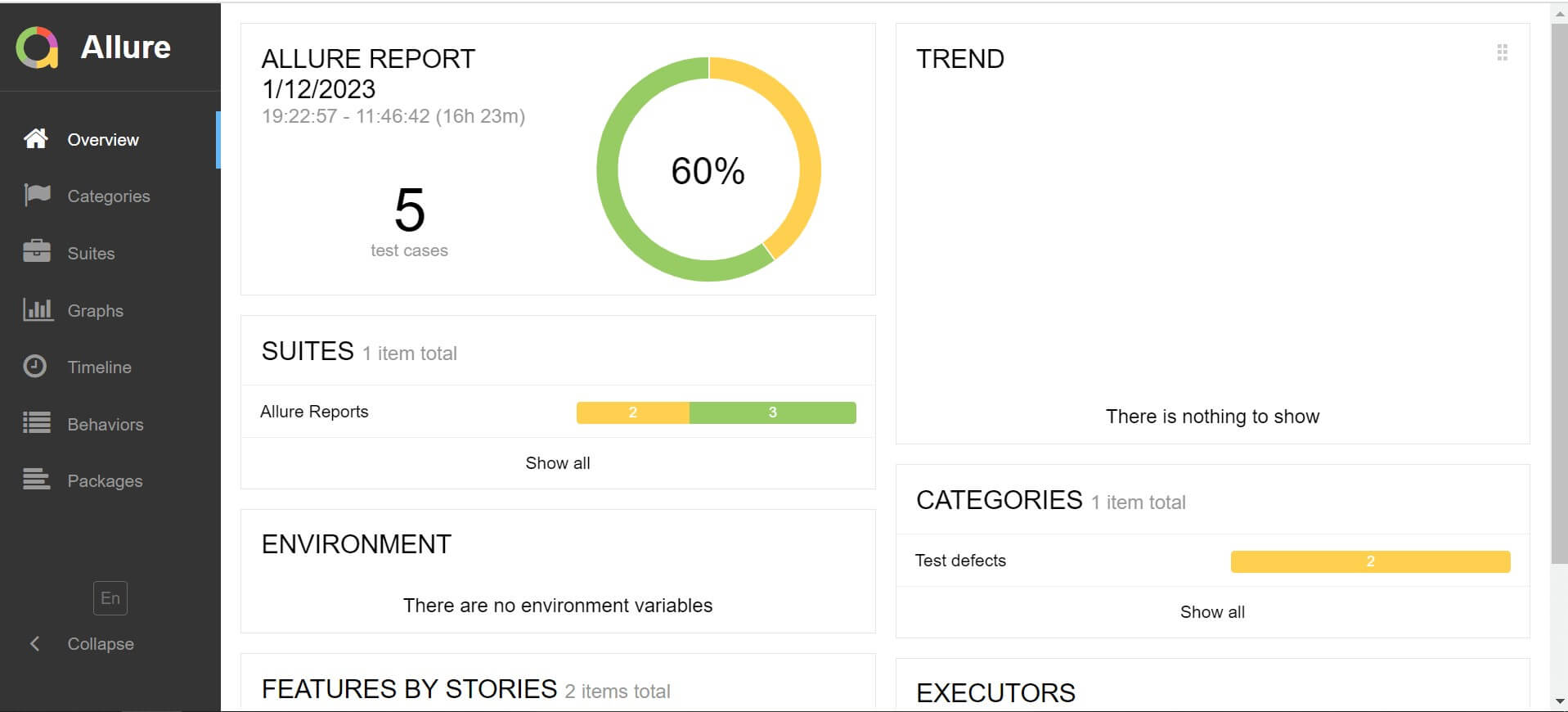
Visual Reports:
The main advantage of using this tool is that the generated reports will be visually appealing with graphical charts. Graphs will help the viewer understand the result in an easily comprehensible way by using Bar Charts or Pie Charts.
So even non-technical people involved in the software development process such as Stakeholders and Business Analysts will understand it with ease.
Though Extent report also makes use of Pie charts, Allure report is far more advanced as we can see in our sample report.
Getting Started with Allure Report
We can add the Allure report to our Maven project by adding the following dependency:
<plugin>
<groupId>io.qameta.allure</groupId>
<artifactId>allure-maven</artifactId>
<version>2.10.0</version>
</plugin>
Important Annotations used in Allure report
@Step – It is used as a step definition to define any modifier with the parameter.
@Epic – It is used to define the large component or a whole product under which Allure depends on.
@Feature – It can be used to represent all the possible test coverages based on the Test scenarios.
@Stories – Every Epic will have many stories and each story represents a sub-product or sub-component.
@Attachment – We will definitely need the screenshots from the test execution in our reports. So we can use this annotation to determine where the screenshot will be placed.
Extent Report
Similar to Allure, Extent report is also an open-source automation test reporting library and can be used with popular automation frameworks such as JUnit, NUnit, Cucumber TestNG, and so on.
Extent Report is good at giving the best report based on the test we run with the preconditions and postconditions we give.
Summarized Reports
Normally, Extent report will summarize the overall automation runs you have made and give you a nice overview of the result. It also gives you information like the number of test cases executed, the passed count, and the failure count.
The passed Scenarios will be seen in Green and the failed scenarios will be seen in Red. So you will be able to quickly filter out the failed tests or passed tests from all the tests based on whatever your need is.
You can also see the categories based on the tags you run the features. You can also see all the reports under the selected category. Additionally, it also gives you the time taken for each test suite as well as individual scenarios to be executed. So, we can even track the estimated time of every run.
So one can say that Extent is on par with Allure in this particular use case.
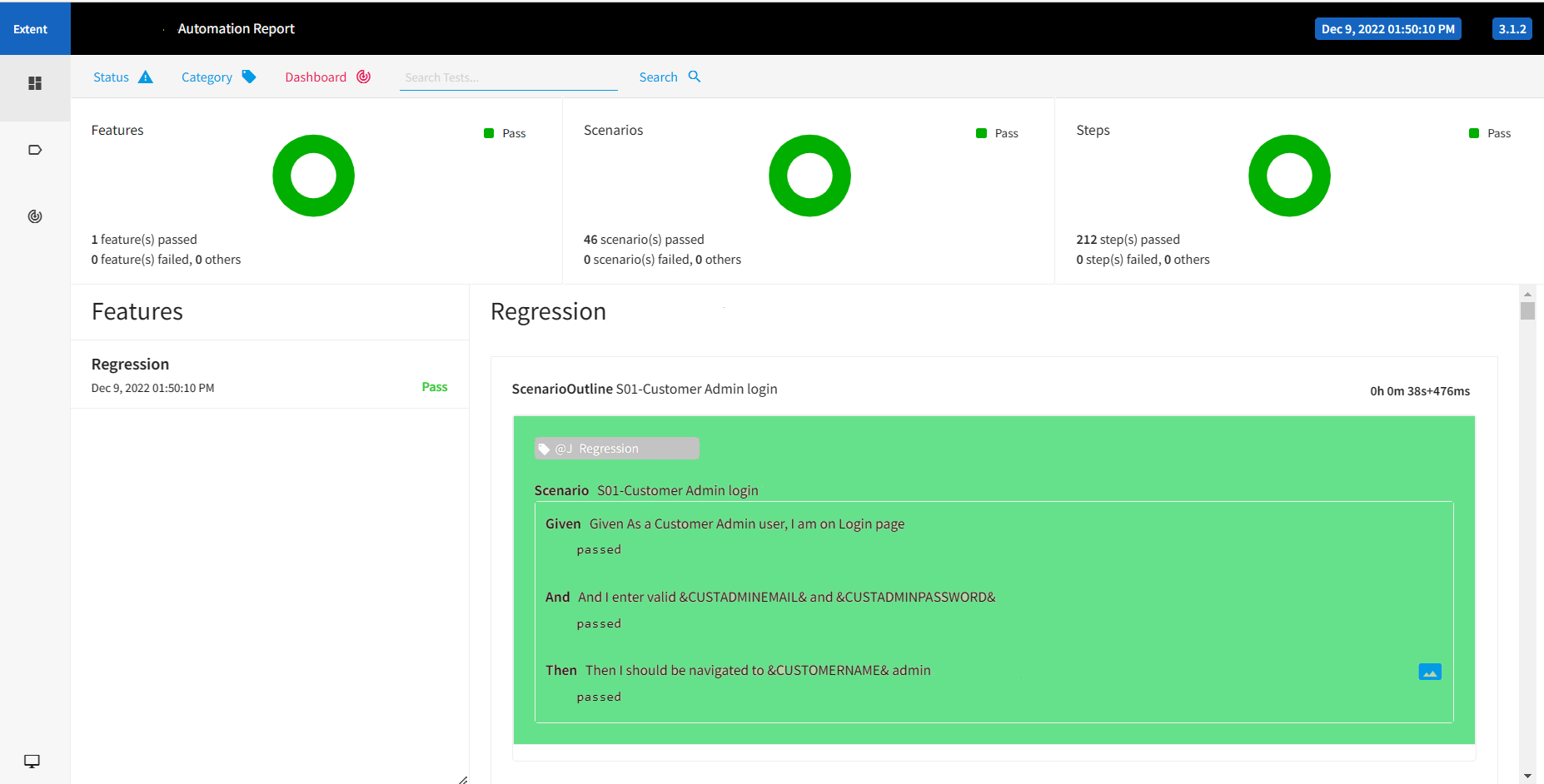
Easy to View:
If your testing needs require you to have the report in pdf format, Extent Report would be the way to go. As seen in the Allure report vs Extent Report comparison table, Allure reports cannot be generated as pdf files. It is also far easier to view Extent reports as you will not need any command line.
Getting Started with Extent Report:
You can generate the extent report in the path that you specify in the syntax as shown below.
ExtentReports reports = new ExtentReports("Path where you want to store the report", true/false);
ExtentTest test = reports.startTest("Name of the Test you wish to run");
The boolean condition here is used to indicate whether you want to overwrite the existing report or want to create a new one every time it runs.
By default, it will consider this option to be “True” and overwrite the existing report every time the test runs.
Important Keywords used in Extent Report
The use of the ExtentTest is that it will add the test steps and logs that have to be added to the previously generated HTML report. It uses some of the keywords such as startTest, endTest, log, and flush for this purpose.
startTest – When you have to add a precondition before the step
endTest – To add any postconditions before the step
Log – To know the status of the steps
Flush – When you have to delete the existing data in the report and generate a new report.
Allure Report vs Extent Report: Final Verdict
Now that we’ve come to the conclusion of our blog, it’s time to give a final verdict. It is usually never a this or that type of an answer as making a decision is purely dependent on the needs of your project. But with that being said, Allure report would be the better choice for most use cases. That is why we have mentioned the individual advantages of both the Allure and Extent to help you make an educated decision. We hope you enjoyed reading our Allure Report vs Extent Report blog. And if you did, make sure to subscribe to our newsletter to never miss out on any of our latest updates.
Frequently Asked Questions
-
Which tool offers better customization options for reporting?
Extent Report offers rich customization options, allowing users to tailor the reports to their specific needs. Allure Report provides customization but focuses more on standardization and integration capabilities.
-
Are these reporting tools open-source?
Allure Report is an open-source tool, making it free to use with community support. Extent Report offers both open-source and paid versions, with the paid version providing additional features and support.
-
Do both reports support multiple programming languages?
Allure Report supports multiple languages and frameworks, allowing for versatile integration across different testing environments. Extent Report primarily integrates with Selenium WebDriver and may have limited support for other languages.
-
Can Allure Report and Extent Report integrate with JIRA?
llure Report supports integration with JIRA, allowing for seamless tracking of issues directly from the test reports. Extent Report does not offer integration with JIRA.
-
Which is better for test automation reporting: Allure or Extent?
Allure Report is ideal for BDD frameworks and teams needing detailed visual reports, while Extent Report is better for customized, structured reporting in Selenium-based projects.
-
Can these reports help with mobile app testing?
Yes, both reports can be used in mobile test automation frameworks to generate detailed execution reports for apps.

by Chris Adams | Jan 12, 2023 | Automation Testing, Blog |
Cypress is a great automation testing tool that has been gaining popularity in recent times. One of the key features of Cypress is that it operates in the same context as the application under test. This allows it to directly manipulate the application and provide immediate feedback when a test fails, making it easier to debug and troubleshoot issues in tests. But the fact of the matter is that no tool is perfect. Being a leading automation testing company, we have used Cypress in many of our projects. And based on our real-world usage, we have written this blog covering the various Cypress limitations that will be beneficial to know about if you have decided to use the tool. So let’s get started.
List of Cypress Limitations
Language Support
Let’s start off our list of Cypress limitations with the number of languages it supports as it is an important factor when you choose a framework. As Cypress is a JavaScript-based testing framework, it is primarily intended to be used with JavaScript and its related technologies.
It does support TypeScript as it is a typed superset of JavaScript. But there is a catch, as you’ll have to transpile your TypeScript code to JavaScript using a build tool like Webpack or Rollup.
Likewise, you can follow the same process to use Cypress with languages like CoffeeScript or ClojureScript by transpiling the code to JavaScript.
Though it seems like a workaround, it is important to note that Cypress wasn’t designed to work with such transpiled code. So you may encounter issues or limitations when using it with other languages other than pure JavaScript. If you do opt to use any other language apart from JavaScript, make sure to thoroughly test if it is fully compatible with the framework.
Testing Limitations
The second major Cypress limitation is the lack of testing capabilities for mobile and desktop applications. As of now, Cypress can be used to test web applications only.
Even in Selenium, you will be able to perform mobile app testing using Appium server. But when it comes to Cypress, you have no such provision to perform mobile app testing.
Browser Support
The next Cypress limitation is the lack of support for browsers such as Safari and Internet Explorer. Though Internet Explorer has been retired by Microsoft, certain legacy applications might still depend on Internet Explorer.
Cypress works with the latest versions of Chrome and Electron. But when it comes to other popular browsers such as Firefox and Microsoft Edge, you’d have to install additional browser extensions. Due to this, these browsers may not exhibit the same level of support as Chrome and Electron. So a few features may not work as expected.
It is also recommended you use the latest version of Chrome or Electron when running your Cypress tests. But if you wish to use an older version of these browsers, these are the supported browsers as of writing this blog.
- Chrome 64 and above.
- Edge 79 and above.
- Firefox 86 and above.
Complexity
Complexity is the next Cypress limitation on our list as it can use only node.js, which is complex and knowledge-demanding. Though typical JavaScript is Synchronous, we’ll have to use asynchronous JS in Cypress. In addition to that, other advanced JavaScript methodologies such as promises and jQuery should also be known.
So if you are starting to learn automation or if you have been using other languages such as Java or Python for your automation, you’ll have a tough time using Cypress.
Multi-Origin Testing
The next Cypress limitation is that performing multi-origin testing is not as easy as it can be done using Selenium. If your automation testing doesn’t involve switching from one domain to another or if it has a different port, problems will arise.
Though the issue was partially addressed with version 12.0.0, you’ll still have to use the cy.origin() command to specify the domain change during such scenarios. Whereas, Selenium doesn’t have any such limitation when it comes to changing the origin domain during the tests.
Similar to this partial workaround, the next two Cypress limitations we are about to see can also be partially overcome with the help of Cypress plugins. We have also written a blog featuring the best Cypress plugins that will make testing easier for you. So make sure to check it out.
XPath Support
XPath is a crucial aspect of automation testing as it is one of the key object locators. But unfortunately, Cypress does not support XPath by default. However, this Cypress limitation is at the tail-end of our list as you can use the cy.xpath() command to evaluate an XPath expression and retrieve the matching elements in the DOM. This command is provided by the cypress-xpath plugin that you’d have to install separately.
iFrame Support
By default Cypress does not support iframes. However, you can use the cy.iframe() command to evaluate iframe actions and retrieve the matching elements in the DOM. But this command can be used only if you have installed the cypress-iframe plugin.
Conclusion
As we had mentioned at the beginning of the blog, no tool is perfect and each would have its own fair share of limitations. Likewise, these are the major Cypress limitations encountered by our dedicated R&D team. Nevertheless, we were still able to use Cypress and reap all the benefits of the tool to deliver effective automation testing services to our clients as these limitations didn’t impact the project needs.
So if these limitations are not huge concerns for your testing needs, you can use Cypress with confidence. If these are actual concerns, it is better you look into the alternatives.

by Mollie Brown | Jan 9, 2023 | Automation Testing, Blog |
A Cypress plugin is a JavaScript module that extends the functionality of the Cypress test runner. They have the ability to create new commands, modify existing commands, and register custom task runners. So knowing the best Cypress plugins can be very useful as you will be able to save a lot of time and streamline your automation testing. Being a leading automation testing company, we have listed out the Best Cypress Plugins we have used in our projects. We have also explained the functionality of these plugins and have mentioned how you can install them as well.
It is important to note that Cypress plugins can be created by anyone. So you can also create a plugin if different projects share a common functionality or utility function that can use one.
But the great advantage here is that Cypress already has a wide range of community-created plugins that cover most of the required functionality such as using XPath, creating HTML reports, and so on.
But before we take a look at the best Cypress plugins and their functionalities, we’ll have to know how to install them.
Installing a Cypress Plugin
Once you have identified a Cypress plugin you wish to use, there are a few standard steps you’ll have to follow to add it to your project. Let’s find out what they are.
But there will be exceptions in a few cases and you’ll need to do a few extra steps to use the plugin. We will explore those exceptions when we look into the best Cypress plugins in detail.
1. Add it as a dependency to your project by using this command
npm install --save-dev @name_of_the_plugin
2. Register the plugin in your Cypress configuration file (cypress.config.js)
Add the object into the “plugins” array as shown in the below example
{
"name": "@name_of_the_plugin"
}
Now that we are aware of the prerequisites you’ll need to know, let’s head directly to our list of the Best Cypress Plugins and find out what makes them so great.
Best Cypress Plugins
@badeball/cypress-cucumber-preprocessor
It is a customized version of the cypress-cucumber-preprocessor plugin that you can use to write Cypress tests in the Gherkin format.
The advantage here is that Gherkin uses natural language statements that make the automation tests very easy to read and understand. Apart from technical people being able to understand the tests, people with no technical knowledge also will be able to understand them. Since that is an important aspect of automation testing, we have added this plugin to our list of the best Cypress plugins.
Once you have installed and registered the plugin using the above-mentioned instructions, you will be able to write your tests using the Gherkin syntax and save them with the .feature file extension. These files will be parsed and converted into executables by the plugin.
@bahmutov/cypress-esbuild-preprocessor
It is a plugin that uses esbuild, a JavaScript bundler to preprocess your test files before they are run by Cypress.
If you are using JavaScript features such as JSX or TypeScript in your tests, this plugin would be useful as esbuild will convert these features to plain JavaScript that can be run in older browsers too.
@badeball/cypress-cucumber-preprocessor/esbuild
The @badeball/cypress-cucumber-preprocessor/esbuild plugin is a custom version of one of the best Cypress plugins we have seen already. As the name suggests, it is a modified version of the cypress-cucumber-preprocessor plugin.
The @badeball/cypress-cucumber-preprocessor/esbuild plugin extends the functionality of writing tests using the Gherkin language by using esbuild. You will be able to transpile your test files using esbuild and parse them using Cucumber before they are run by Cypress.
This can be very useful if you are using modern JavaScript features such as JSX or TypeScript in your tests.
@cypress/xpath
Using an XPath to locate elements for your automation tests is a very common practice in automation testing. And you can make use of the @cypress/xpath plugin to add support for using XPath expressions in your tests.
It can be particularly useful when you have to target elements that don’t have unique ID attributes, or if you want to locate elements based on their exact position or relative position with respect to other elements.
You can target elements in your tests by using the cy.xpath() command.
Cypress-iframe
iframes are HTML elements that allow you to embed another HTML document within the current page. They are used in numerous websites as they can be useful for displaying content from external sources or for separating different sections of a page.
If the site you are testing does have an iframe, you’ll have to know how to interact with it in your automation tests. So you can make use of the cypress-iframe plugin to shift the focus of your tests to an iframe element.
Cy-verify-downloads
As the name suggests, this Cypress plugin can be used to validate if a file has been downloaded during your automation testing. It is common for applications to offer file downloads to their users and that is why this plugin has found its spot in our list of best Cypress plugins.
It basically uses two arguments to fulfill its purpose, and they are the file path and the expected content of the download file. So you can use cy.verifyDownload() command to ensure that your application is generating and serving the correct files to users.
Multiple-cucumber-html-reporter
Reporting is a very important part of automation testing and we have chosen a plugin that will help you generate HTML reports for your tests. The Multiple-cucumber-html-reporter is a plugin for the Cucumber test framework that generates an HTML report for your tests.
Cucumber is a tool that allows you to write tests using natural language statements (written in the Gherkin syntax), and the Multiple-cucumber-html-reporter plugin allows you to generate an HTML report that shows the results of these tests.
Of our list of the best Cypress plugins, this is the only plugin that has an exception when it comes to using it after installation and registration. You’ll have to configure the plugin to generate the report in the format you want.
As usual, you can use the below command to install the plugin as a dependency on your project.
npm install --save-dev multiple-cucumber-html-reporter
After which, you’ll have to configure the plugin by creating a JavaScript file that requires the plugin. You can configure the JavaScript file with the appropriate conditions based on which your HTML report will be generated. Let’s take a look at an example to help you understand it clearly.
Example:
Let’s generate an HTML report based on the JSON files in the “path/to/json/files” directory and save it to the “path/to/report/directory” directory. We will be including metadata about the browser & platform used to run the tests and a few custom data such as the title and additional details about the project and release.
const reporter = require("multiple-cucumber-html-reporter");
reporter.generate({
jsonDir: "path/to/json/files",
reportPath: "path/to/report/directory",
metadata: {
browser: {
name: "chrome",
version: "78.0"
},
device: "Desktop",
platform: {
name: "Windows",
version: "10"
}
},
customData: {
title: "My Report",
data: [
{ label: "Project", value: "My Project" },
{ label: "Release", value: "1.0.0" },
{ label: "Execution Date", value: "January 1, 2020" }
]
}
});
cypress-file-upload
Similar to applications having the provision to download files, the ability to upload files from the local system to the server is also a common function. So you can make use of this plugin to test if your application uploads a file as expected.
cy.upload_file is the command you’ll have to use to get this functionality.
Conclusion
As mentioned earlier, there are so many great Cypress plugins and we found these to be the most important ones that every automation tester must know. We hope you are now clear about how to install, register, and use all of the best Cypress plugins we’ve gone through in our blog. Even if you wish to use any other Cypress plugin, you can make use of the standard installation and registration process to get started with it. Being an experienced automated testing as a service provider, we have published numerous informative blogs about Cypress and will be publishing more. So make sure to subscribe to our newsletter to ensure you do not miss out on any of our latest posts.




















